Alias (Volume 1) – music by Michael Giacchino
 As we’re counting down to the relaunch of the Enterprise on the big screen, I thought this would be an opportune time to check the back catalogue of the latest celebrated composer to put his stamp on the final frontier: Michael Giacchino. After laboring away in the often-anonymous field of video game music, Giacchino began making his name known as a potential A-list composer with J.J. Abrams’ Alias. I wasn’t a huge fan of Alias, but in listening to the two volumes of soundtracks released from the show, I have become a huge fan of its music.
As we’re counting down to the relaunch of the Enterprise on the big screen, I thought this would be an opportune time to check the back catalogue of the latest celebrated composer to put his stamp on the final frontier: Michael Giacchino. After laboring away in the often-anonymous field of video game music, Giacchino began making his name known as a potential A-list composer with J.J. Abrams’ Alias. I wasn’t a huge fan of Alias, but in listening to the two volumes of soundtracks released from the show, I have become a huge fan of its music.
The ironic thing is that, in its more introspective, moody moments, Alias leaned on orchestral music that’s nearly indistinguishable from the music for an episode of Lost (also produced by Abrams and scored by Giacchino). But much of Alias’ music leans in a completely different direction: upbeat, techno-beat-drenched pieces that seem to pay homage to, in equal parts, John Barry’s balls-to-the-wall brassy James Bond scores and the ethnic-location-of-the-week music from Mission: Impossible’s original TV run. Since these scenes almost always accompanied the sight of Jennifer Garner strutting her stuff or kicking butt (and, more often than not, doing both simultaneously), the beat seldom lets up.
The orchestra gets plenty to do in the action scenes, too, but in this case it sounds very little like Lost. One track in particular, though – “On To Paris” – spends a little bit of time combining the techno beats with the kind of low, snarling brass Giacchino frequently uses on Lost, and the effect is quite interesting – the addition of a simple drum beat completely changes the character and mood. One gets the impression very quickly that Alias is what landed Giacchino the scoring assignment for The Incredibles, for which he was nominated for an Oscar, and that’s led to nearly everything since, ranging from Ratatoullie to Star Trek. As calling cards go, you can’t do much better than the music from Alias: its ever-changing settings made for plenty of opportunities for musical variety, and Giacchino didn’t squander that opportunity by phoning in generic music.
 So, should the beat-heavy Alias point the way for Giacchino’s Star Trek score? I’m going to hazard a guess that it probably won’t, but if it did…why not? The new movie is an exercise in trying to push classic Trek into a new style for a new audience. Michael Giacchino is one of a wave of incredibly talented young composers who are currently rewriting the books: not everything has to be in a European romantic style. Why not punch up the music and make it more modern? Alias proved that Giacchino was adept at splitting the difference between both styles.
So, should the beat-heavy Alias point the way for Giacchino’s Star Trek score? I’m going to hazard a guess that it probably won’t, but if it did…why not? The new movie is an exercise in trying to push classic Trek into a new style for a new audience. Michael Giacchino is one of a wave of incredibly talented young composers who are currently rewriting the books: not everything has to be in a European romantic style. Why not punch up the music and make it more modern? Alias proved that Giacchino was adept at splitting the difference between both styles.
- Alias (0:27)
- Dissolved (2:07)
- Red Hair Is Better (2:31)
- Spanish Heist (4:31)
- Double Life (1:54)
- Tunisia (4:14)
- In The Garden (2:32)
- Looking For A Man (3:54)
- Anna Shows Up (3:33)
- Home Movies (0:42)
- On To Paris (1:51)
- Page 47 (1:55)
- The Prophecy (2:11)
- Badenweiler (5:11)
- Arvin At The Poles (1:38)
- Sleeping Beauty (3:11)
- Blow’d Up (2:28)
- It’s Not The CIA (1:41)
- Oh My God!!! (3:19)
- The Tooth Doctor (2:01)
- It Was Anna (0:56)
- Wet Suits (2:40)
- Ball Buster (1:42)
- The End (0:58)
- Bristow & Bristow (3:31)
- SD-6 Dance Party (3:18)
Released by: Varese Sarabande
Release date: 2003
Total running time: 64:56
Terminator: The Sarah Connor Chronicles – music by Bear McCreary
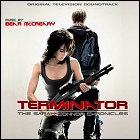 Since making a splash in the film music scene with his distinctive music for the new Battlestar Galactica, Bear McCreary has earned not only acclaim, but a very busy schedule on the scoring stage. In addition to direct-to-DVD horror movies like the Rest Stop series, McCreary has also taken over the musical duties on Sci-Fi’s Eureka, and in each case, he’s done so in such a way that the results don’t scream “This is the guy who does the music for Battlestar Galactica” – and really, that’s a good thing. That’s the sort of diverse talent that keeps composers employed.
Since making a splash in the film music scene with his distinctive music for the new Battlestar Galactica, Bear McCreary has earned not only acclaim, but a very busy schedule on the scoring stage. In addition to direct-to-DVD horror movies like the Rest Stop series, McCreary has also taken over the musical duties on Sci-Fi’s Eureka, and in each case, he’s done so in such a way that the results don’t scream “This is the guy who does the music for Battlestar Galactica” – and really, that’s a good thing. That’s the sort of diverse talent that keeps composers employed.
For those wishing that there was more music in the same vein as Galactica’s percussive moodiness, though, Terminator: The Sarah Connor Chronicles fits the bill. The series itself kicked off with the same kind of world-weary hope-in-the-face-of-a-fatalistic-future tone that Galactica has carried throughout its run, but let’s face it, it’s almost certain that Galactica’s wall-of-percussion action scenes are what landed McCreary this job. The Sarah Connor Chronicles utilizes plenty of metallic percussion, though often sampled and processed heavily – appropriate for a show that deals with robotic assassins from the future.
Galactica fans will also find this show’s use of a small string ensemble familiar, appearing at several points in the soundtrack to deliver low-key, almost mournful moments in stark contrast to the pounding percussion. Both elements come together in the show’s end title theme, with an effect that’s equal parts apocalyptic and Celtic. Unlike the main title theme, which is heavy on percussion and light on melody, the end titles are based on “Sarah Connor’s Theme” (heard in full on track 3).
On the opposite end of the spectrum from that theme, there’s the busy, almost Art Of Noise-like “Motorcycle Robot Chase”, loaded with scraping metal percussion, stuttering electronic sting notes, and just plain noise. Needless to say, this track goes nuts in a way that wouldn’t fit on Galactica – it’s uniquely Sarah Connor Chronicles, and easily the busiest track on the entire album by miles.
Two songs are included, “Samson And Delilah” (performed by Shirley Manson of Garbage, who joined the cast as part of a rethink of the show’s format in season two), and the raucous “Ain’t We Famous”, performed by Brendan McCreary and his band (also responsible for some of Galactica’s more mainstream musical moments, such as “All Along The Watchtower”). “Samson And Delilah” didn’t really strike me as radically different from anything I’ve heard from Ms. Manson before, but “Ain’t We Famous” is a fun, rockin’ number that stands up to repeat listening better. An homage to Carl Stalling – about the last thing I expected to hear here – is included as well (“Atomic Al’s Merry Melody”).
 I’m going to fess up that I’m not a huge fan of the show itself, but its music is certainly worthy of attention. Fans of Battlestar Galactica’s music will enjoy this one, whether they’ve followed the series or not, because it’s on very familiar ground (and yet slightly different) musically. This’ll tide you over until the next Galactica soundtrack quite nicely.
I’m going to fess up that I’m not a huge fan of the show itself, but its music is certainly worthy of attention. Fans of Battlestar Galactica’s music will enjoy this one, whether they’ve followed the series or not, because it’s on very familiar ground (and yet slightly different) musically. This’ll tide you over until the next Galactica soundtrack quite nicely.
- Samson And Delilah (4:58)
- Terminator: The Sarah Connor Chronicles Main Titles (0:45)
- Sarah Connor’s Theme (3:17)
- Cromartie In The Hospital (1:10)
- Andy Goode’s Turk (3:11)
- Central America (1:34)
- John And Riley (2:27)
- Derek Reese (2:53)
- Ain’t We Famous (3:36)
- Motorcycle Robot Chase (2:50)
- The Hand Of God (3:10)
- Prisoners Of War (6:26)
- Miles Dyson’s Grave (2:43)
- Atomic Al’s Merry Melody (1:23)
- The Reese Boys (1:41)
- Removing Cameron’s Chip (3:15)
- Ellison Spared (2:23)
- I Love You (2:30)
- Catherine Weaver (2:05)
- Derek’s Mission (1:47)
- There’s A Storm Coming (3:02)
- Highway Battle (3:58)
- Perfect Creatures (2:15)
- Terminator: The Sarah Connor Chronicles End Titles (0:35)
Released by: La-La Land Records
Release date: 2008
Total running time: 63:54
Jellyfish – Fan Club
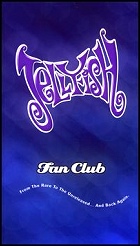 Jellyfish is a star that burned brightly but too briefly in the power pop firmament, blasting itself to bits in a kind of dull supernova of creative differences after only two albums. To say that those two albums have attracted a following would be something of a massive understatement: there’s actually a tribute album out, and even brief association with Jellyfish has made cult rock heroes out of musicians like Jason Falkner, Roger Manning and Tim Smith. For music fans who missed the pop revolution of the 1970s, Jellyfish rolled almost all of that experience into those two albums, spruced up for the early ’90s. For a band with a legacy of two albums and a handful of B-sides, Jellyfish is cited as a seminal influence by an alarming number of artists these days.
Jellyfish is a star that burned brightly but too briefly in the power pop firmament, blasting itself to bits in a kind of dull supernova of creative differences after only two albums. To say that those two albums have attracted a following would be something of a massive understatement: there’s actually a tribute album out, and even brief association with Jellyfish has made cult rock heroes out of musicians like Jason Falkner, Roger Manning and Tim Smith. For music fans who missed the pop revolution of the 1970s, Jellyfish rolled almost all of that experience into those two albums, spruced up for the early ’90s. For a band with a legacy of two albums and a handful of B-sides, Jellyfish is cited as a seminal influence by an alarming number of artists these days.
In 2002, Not Lame Records assembled this box set – with label founder Bruce Brodeen putting his home on the line to pay for the licensing and duplication – featuring demos, rare tracks, and even live appearances. In the grand scheme of things, there’s precious little in the way of new music – in this context, meaning completely new songs – that fans haven’t heard before, but there’s still enough here to cover four discs.
The Bellybutton demos feature several songs that I hadn’t heard before, which simply didn’t make the cut for the band’s first album. While they’re not bad songs, they’re just not quite on the same level as “The King Is Half-Undressed” or “The Man I Used To Be”, including a very early version of “Bye Bye Bye” (which ended up on Spilt Milk) and a cover of Donovan’s “Season Of The Witch”, among other things.
Jumping ahead to the disc of Spilt Milk demos and outtakes, and other songs from the same era, it’s easy to tell that even the demos were so intricate and polished that they would’ve done many an artist proud as final mixes. Not so for Jellyfish, though – and one wonders if that quest for perfection (and the inevitable headaches that result from that quest) isn’t what drowned Jellyfish once and for all. There are numerous new songs on this disc as well, including a cluster of demos recorded of songs that Manning and Andy Sturmer penned for potential inclusion on a Ringo Starr solo album. They’re all good stuff, very well pitched to Ringo’s strengths and the styles he and his listeners are accustomed to, but they wouldn’t have been bad Jellyfish songs in their own right either – that, perhaps, being the no-lose propostion in cooking up a bunch of Ringo-esque/borderline-Beatlesque songs: whatever Ringo didn’t want was probably a likely candidate for the third album that never happened. The only song that seems like the odd man out from the “Ringo demos” is “Watchin’ The Rain”, a song which just never quite seems like something that either Ringo or Jellyfish would’ve done – a kind of nondescript ’80s-style ballad. On the opposite end of that spectrum is the dead-center perfect tribute to the Beatles that is “I Don’t Believe You”. If you didn’t know it was Jellyfish, you’d probably swear that it was some previously undiscovered tune by the Fab Four themselves.
B-sides as well as one-off soundtrack and compilation singles that were released between Bellybutton and Spilt Milk land on this disc as well, including the infamous Super Mario Bros.-themed “Ignorance Is Bliss”, originally released on 1991’s all-star Nintendo White-Knuckle Scorin’! album, back from the days when Nintendo was nearly eclipsing just about everything else on the pop culture scene. Unlike most artists who contibuted a single to that compilation, Jellyfish actually did their homework and delivered a song that’s literally about Super Mario – from King Koopa’s perspective! It’s destined to go down as a disposable novelty single, but it’s worth at least a couple of listens for the sheer musicality of it. Disposable novelty song or not, the group poured a lot of effort into it.
The live discs are a revelation, showing the sheer determination of the group to replicate their complex sound on stage. That they actually pull it off, more often than not, without significantly dumbing down the arrangements of either their own densely-orchestrated pieces or any number of cheekily chosen covers, is just this side of a miracle, again a testament to the combined musical skill of Jellyfish. The Spilt Milk live disc really shines, including a couple of demonstrations of an addition that the group made to the set list just for concerts in Japan. (It’s probably no surprise that Andy Sturmer, post-Jellyfish, went on to produce Puffy Amiyumi, and most of the former Jellyfishers’ solo and side projects have far, far less difficulty finding a label home in Japan than they do anywhere in the English-speaking world. Obviously they made their impact in Japan.) The last track on the last CD is the Jellyfish cover of “Think About Your Troubles”, the group’s 1994 contribution to a posthumous Harry Nilsson tribute album, and the last thing they recorded.
So what’s the sum total of these four discs of on-stage antics and in-studio rarities? If the two studio albums alone didn’t do it for you, Fan Club will finish the job of filling your ears with glee and filling your heart with melancholy that Jellyfish, as an entity whose whole was at least as great as the sum of its very  talented parts, didn’t continue. The demos and B-sides and other tracks, stuff that the band felt was not album material or single material, are – for the most part – better than a lot of stuff that other groups feel is album material or single material. Jellyfish wasn’t a band that could do no wrong, but in the space of two albums and at least any many years’ worth of touring, Jellyfish also hadn’t dropped anything lamentably bad in our ears. This was a group that burned bright and burned out fast, the only consolation being that its various members are still active turning out their own stellar pop music.
talented parts, didn’t continue. The demos and B-sides and other tracks, stuff that the band felt was not album material or single material, are – for the most part – better than a lot of stuff that other groups feel is album material or single material. Jellyfish wasn’t a band that could do no wrong, but in the space of two albums and at least any many years’ worth of touring, Jellyfish also hadn’t dropped anything lamentably bad in our ears. This was a group that burned bright and burned out fast, the only consolation being that its various members are still active turning out their own stellar pop music.
Disc One: The Bellybutton Demos, 1988-89
- The Man I Used To Be (4:23)
- Bedspring Kiss (4:45)
- Deliver (3:07)
- Now She Knows She’s Wrong (2:15)
- Queen Of The USA (5:13)
- Always Be My Girl (3:36)
- I Wanna Stay Home (4:10)
- Let This Dream Never End (3:59)
- Season Of The Witch (4:22)
- That Girl’s A Man (3:42)
- Calling Sarah (4:48)
- All I Want Is Everything (3:12)
- Bye Bye Bye (3:48)
- She Still Loves Him (4:27)
- Baby’s Coming Back (2:53)
- The King Is Half-Undressed (3:40)
Disc Two: The Bellybutton Tour, 1990-91
- MTV Top Of The Hour (0:20)
- Much Music, Canada (0:30)
- The King Is Half-Undressed (3:49)
- Sugar And Spice (2:14)
- 91X, San Diego (0:19)
- Two All-Beef Patties (0:15)
- Mr. Late (3:38)
- No Matter What (2:43)
- All I Want Is Everything (4:25)
- Much Music, Canada (1:07)
- Hold Your Head Up / Hello (5:24)
- Calling Sarah (4:06)
- She Still Loves Him (4:08)
- Will You Marry Me (6:41)
- Baby Come Back / Baby’s Coming Back (4:25)
- Now She Knows She’s Wrong (2:50)
- Let ‘Em In / That Is Why (5:12)
- Jet (3:18)
- Much Music, Canada (0:37)
- The King Is Half-Undressed (3:38)
- Baby’s Coming Back (2:57)
- I Wanna Stay Home (4:05)
- She Still Loves Him (3:51)
- All I Want Is Everything (4:24)
Disc Three: The Spilt Milk Demos, 1991-92
- World Cafe (0:40)
- Spilt Milk Intro (0:44)
- Hush (1:18)
- Joining A Fan Club (3:45)
- Sabrina, Paste And Plato (2:11)
- New Mistake (4:05)
- Glutton Of Sympathy (4:02)
- The Ghost At Number One (3:25)
- All Is Forgiven (4:09)
- Russian Hill (4:43)
- He’s My Best Friend (3:42)
- Family Tree (4:00)
- Spilt Milk Outro (1:14)
- Ignorance Is Bliss (3:55)
- Worthless Heart (3:06)
- Watchin’ The Rain (4:11)
- I Need Love (3:09)
- I Don’t Believe You (3:21)
- Long Time Ago (3:47)
- Runnin’ For Our Lives (3:40)
- Fan Club message (6:02)
Disc Four: The Spilt Milk Tour, 1993
- Glutton Of Sympathy (4:58)
- Baby’s Coming Back (3:01)
- That Is Why (3:30)
- The Ghost At Number One (3:29)
- Joining A Fan Club (2:51)
- World Cafe (1:09)
- I Can Hear The Grass Grow (3:26)
- New Mistake (4:03)
- Eleanor Rigby (1:35)
- S.O.S. (1:14)
- S.O.S. (2:08)
- All Is Forgiven (4:12)
- Sabrina, Paste And Plato (2:25)
- Joining A Fan Club (4:35)
- The Ghost At Number One (3:49)
- The Man I Used To Be (4:48)
- Glutton Of Sympathy (4:04)
- New Mistake (4:43)
- Think About Your Troubles / hidden track: The King Is Half-Undressed (11:00)
Released by: Not Lame Records
Release date: 2002
Disc one total running time: 62:20
Disc two total running time: 74:56
Disc three total running time: 69:09
Disc four total running time: 71:00
Split Enz – The Rootin’ Tootin’ Luton Tapes
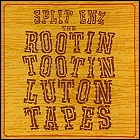 For much of of 1978, Split Enz seemed to have reached the end of the road. Having lost their label contract, their management, and almost all of their live work, the band was stranded in England with only a grant from the Queen Elizabeth Arts Council in their native New Zealand to sustain them through the lean times. At this point, lead singer/songwriter Tim Finn’s younger brother, Neil, had been with the band for less than a year. With no concerts to play, the emphasis was on writing and rehearsing (and, when they could afford it, recording) new material, and with Phil Judd having come and gone again, Neil had his first chance to try to add his own songwriting touch to the band’s sound. In June and July of 1978, the Enz converged on a studio in Luton to record their new material, with songs written by both of the Finns. And the irony of it is that only a few of those recordings have been heard until now.
For much of of 1978, Split Enz seemed to have reached the end of the road. Having lost their label contract, their management, and almost all of their live work, the band was stranded in England with only a grant from the Queen Elizabeth Arts Council in their native New Zealand to sustain them through the lean times. At this point, lead singer/songwriter Tim Finn’s younger brother, Neil, had been with the band for less than a year. With no concerts to play, the emphasis was on writing and rehearsing (and, when they could afford it, recording) new material, and with Phil Judd having come and gone again, Neil had his first chance to try to add his own songwriting touch to the band’s sound. In June and July of 1978, the Enz converged on a studio in Luton to record their new material, with songs written by both of the Finns. And the irony of it is that only a few of those recordings have been heard until now.
Approximately half of the songs recorded at Luton were honed further and re-recorded from scratch as the group’s 1979 album Frenzy. The other half were occasionally dusted off (and sometimes re-recorded) as B-sides for singles (this being back in the days when there were still physical singles, and when those singles still had B-sides), while others never saw the light of day. Poised precariously between the original Split Enz remit of arty, complicated rock with ambitious arrangements and challenging tempo changes, and the group’s more sharply-focused ’80s pop-going-on-new-wave sound, these are the Luton sessions, revealed at last after 30 years to satisfy relentless pressure from the group’s loyal fans down through the years.
Is there a reason these recordings weren’t issued at some point back then? Well…yeah. They’re definitely diamonds in the rough, and there’s almost zero stylistic unity in the material. With nothing to lose (how much lower could they go from being unemployed in another country, with no recording contract and no promotion?), the band can clearly be heard revisiting its old sound, taking various approaches to revamping it, and even trying on and discarding whole new styles as they saw fit. The bulk of the songs are still Tim’s, though the tunes written by Neil are a revelation. Some of the songs represent his earliest songwriting efforts, as well as some of his earliest outings as a professional musician. His singing voice is, to be charitable, unrefined in places, but the pure catchiness of his songwriting offsets that. “Carried Away” and “Holy Smoke” originated here, as did “Late In Rome”, better known as “Serge”.
Tim’s contributions aren’t anything to sneeze at, however – “Semi-Detached” (one of my favorite songs that the man’s ever written), “Hypnotized”, “Next Exit” and “Remember When” originate from the Luton sessions, among many others. It’s with Tim’s songs that one can hear the most stylistic experimentation; “Hypnotized” is performed almost in the style of ’50s blues-rock, with a typically Enz twist, and some of Tim’s other tunes are similarly poised between the Enz’ early ’70s music-hall-inspired sound and more instantly accessible styles.
There are other landmarks to be heard here, especially if one has the two-disc version that was made available only to the Frenz Of The Enz fan club. That second disc, not available at retail, consists primarily of early mixes of the songs from Frenzy. Some of them, such as “Frenzy” itself, is in a decidedly unfinished form. But that disc also contains other tunes as well – Phil Judd’s last two contributions to the Enz as songwriter, “I’m So Up” and “So This Is Love”, are on the fan-club-only disc, as is “Livin’ It Up”, a song by relatively new recruit Nigel Griggs, which sees the Enz belly up to the edge of punk…and apparently back away slowly again. Judd’s two songs are a sharp reminder that, as much as some listeners regard him as the architect of the Enz’s weirder excesses, he was as capable of coming up with catchy, three-or-four-minute gems just as the Finn brothers were.
Other unusual writing credits appear; the first disc features a Griggs/Tim Finn collaboration, “Creature Comforts”, “Straight Talk” (co-written by the elder Finn and former Enz sax/horn player Robert Gillies, who had departed the band by this point and embarked on an art career that would later see him serving as, of all things, production designer for Xena: Warrior Princess), and an atmospheric-but-rather-strange song called “Animal Lover” by Eddie Rayner. These songs likely emerged from group jams – it was about as close as the Enz would ever get to an all-hands-pitch-in kind of band. The rest of the time, barring a few Eddie Rayner instrumentals, it seems that the band’s music came from the minds of Judd and/or one Finn or the other. It’s an interesting peek into avenues left unexplored. The first-ever songwriting collaboration between the Finn brothers, “Best Friend”, can also be heard, though it’s not something you’d probably be expecting if your indoctrination into the Finns’ duets was Woodface or the Finn Brothers albums.
It’s worth noting that purists might object to one thing: Rayner remixed many of the recordings, though not all. The two Judd songs originate from an appearance on the BBC’s Dave Lee Travis show, and some were left alone or had been mixed down and couldn’t be remixed. “Semi-Detached” is one such example of a song left untouched, and it certainly didn’t need any revising. But to be honest, purist or no, I’ve never heard the Luton tapes in their original state – and I doubt too many can say that they have either – so it’s not as if I have something to compare this release to so I can hear what’s changed. I also appreciate that the bulk of the Frenzy material is on the second disc only; as Frenzy is still available commercially, these alternate takes amount to music deleted scenes and outtakes (though the band is said to prefer the raw passion of the original recordings). Those who only want to hear stuff they’ve never heard before can do just fine with the single-disc version.
 Ultimately, this collection, in either single or double disc form, may really be for-fans’-ears-only material. These aren’t new Split Enz songs (nor are there likely to be any), but the vast majority of the songs on the first disc, and a fair few on the second disc, will be new to most fans’ ears, and I’m not one to pass up on the chance to hear something new – or even just new-to-me – from either Finn. It’s a fascinating glimpse into the group’s “year from hell,” in an English summer three decades ago.
Ultimately, this collection, in either single or double disc form, may really be for-fans’-ears-only material. These aren’t new Split Enz songs (nor are there likely to be any), but the vast majority of the songs on the first disc, and a fair few on the second disc, will be new to most fans’ ears, and I’m not one to pass up on the chance to hear something new – or even just new-to-me – from either Finn. It’s a fascinating glimpse into the group’s “year from hell,” in an English summer three decades ago.
Disc one
- Miss Haps (4:08)
- Home Comforts (4:13)
- Animal Lover (3:16)
- Carried Away (4:37)
- Semi-Detached (5:03)
- Holy Smoke (3:21)
- Message Boy (3:47)
- Hypnotised (3:41)
- Late In Rome (3:25)
- Straight Talk (3:23)
- Hollow Victory (3:23)
- Evelyn (3:16)
- Best Friend (3:04)
- Creature Comforts (2:52)
- Remember When (3:56)
Disc two – Frenz of the Enz version only
- Hermit McDermitt (5:02)
- Betty (6:13)
- I See Red (3:15)
- Mind Over Matter (3:09)
- Next Exit (3:54)
- She Got Body She Got Soul (2:57)
- So This Is Love (4:14)
- Abu Dhabi (4:53)
- Famous People (4:02)
- I’m So Up (2:58)
- Marooned (2:27)
- Livin’ It Up (1:17)
- Frenzy (3:07)
Released by: Rhino
Release date: 2007
Disc one total running time: 55:25
Disc two total running time: 47:28
Ben Folds – Way To Normal
 Ben Folds’ first entire album of new material since 2005’s Songs For Silverman (Supersunnyspeedgraphic really just being a compilation of material that had been tried out on limited-run EPs first), Way To Normal heralds Folds’ return to the U.S. (accompanied by the almost prerequisite seismic changes in his personal life), and as a result, the musical tone shifts wildly from song to song.
Ben Folds’ first entire album of new material since 2005’s Songs For Silverman (Supersunnyspeedgraphic really just being a compilation of material that had been tried out on limited-run EPs first), Way To Normal heralds Folds’ return to the U.S. (accompanied by the almost prerequisite seismic changes in his personal life), and as a result, the musical tone shifts wildly from song to song.
There are songs that are immediately accessible (the duet “You Don’t Know Me”, set to a drum machine beat with sampled strings, and “Cologne” and “Kylie From Connecticut”, both reminiscent of Folds’ best ballads), and some that may take a bit of time to grow accustomed to. “The Frown Song” is a nifty little number whose mosquito-like synths may be off-putting at first, and “Brainwashed” with its overpowering drum beat instantly brought New Radicals’ “You Get What You Give” to mind. “Errant Dog” and “Bitch Went Nuts” will appeal to fans of quirky Ben Folds Five numbers like “Song For The Dumped”. I can’t quite get my head around “Free Coffee”, but that’s simply because of the production choices made and not the song itself – there’s a very hissy, high-frequency sound running through most of the song that I just find irritating. As a fan of production-driven orchestrated rock, I’m all for trying out daring things at the mixing board, but if it drives the listener away, what’s the point?
 The usual caveats apply to Folds’ music – no-holds-barred language (it definitely earns its dreaded “parental advisory” sticker on the cover) being chief among them – but long-term Folds fans will probably be (mostly) pleased. It’s just that there are a couple of tracks here that might throw even the devout followers; the album title itself seems to hint that Folds is trying to find his way back to normal (no, it’s not a text-message-speak-era typo of “way too normal”)…and maybe the next album will be a four-star offering once he gets there and life settles down a bit for him.
The usual caveats apply to Folds’ music – no-holds-barred language (it definitely earns its dreaded “parental advisory” sticker on the cover) being chief among them – but long-term Folds fans will probably be (mostly) pleased. It’s just that there are a couple of tracks here that might throw even the devout followers; the album title itself seems to hint that Folds is trying to find his way back to normal (no, it’s not a text-message-speak-era typo of “way too normal”)…and maybe the next album will be a four-star offering once he gets there and life settles down a bit for him.
- Hiroshima (B-B-B-Benny Hit His Head) (3:37)
- Dr. Yang (2:30)
- The Frown Song (3:37)
- You Don’t Know Me featuring Regina Spektor (3:11)
- Before Cologne (0:53)
- Cologne (5:02)
- Errant Dog (2:24)
- Free Coffee (4:01)
- Bitch Went Nuts (3:06)
- Brainwascht (3:48)
- Effington (3:32)
- Kylie From Connecticut (4:44)
Released by: Sony
Release date: 2008
Total running time: 40:25
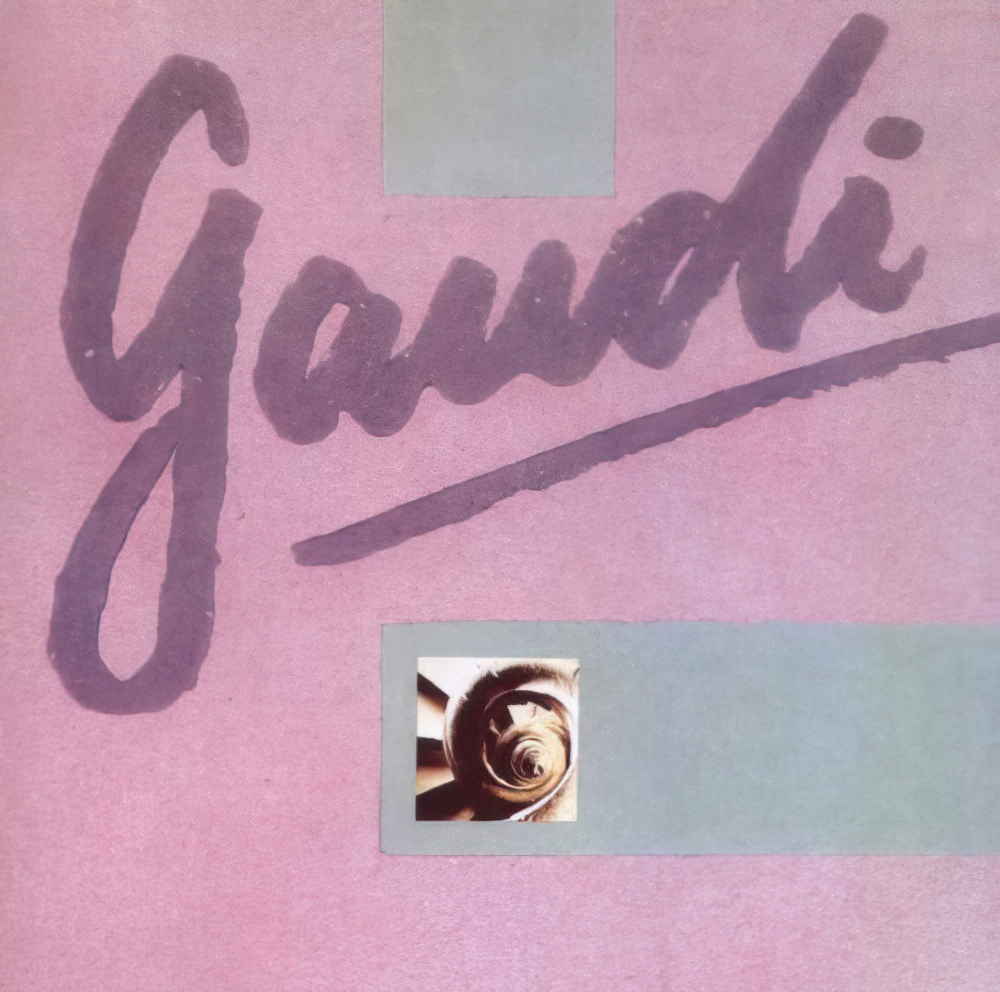
Alan Parsons Project – Gaudi (remastered)
 The last Alan Parsons Project album to be released under that band name is also the last of the Alan Parsons Project remasters, and thus Gaudi ends two stories at the same time. I can’t really tell how much actual remastering was done here – Gaudi was originally recorded on fairly high-end digital equipment to begin with, and though that means digital-to-tape rather than a hard drive, it was always a very sharp recording. It’s probably best known for “Closer To Heaven” and “Money Talks”, both of which appeared on Miami Vice at the time of the original release, and “Paseo de Gracia”, which I remember being a staple of the Weather Channel forecast music at the time.
The last Alan Parsons Project album to be released under that band name is also the last of the Alan Parsons Project remasters, and thus Gaudi ends two stories at the same time. I can’t really tell how much actual remastering was done here – Gaudi was originally recorded on fairly high-end digital equipment to begin with, and though that means digital-to-tape rather than a hard drive, it was always a very sharp recording. It’s probably best known for “Closer To Heaven” and “Money Talks”, both of which appeared on Miami Vice at the time of the original release, and “Paseo de Gracia”, which I remember being a staple of the Weather Channel forecast music at the time.
In remastered form, we get to hear the gestation of several of the songs, with early drafts of “Paseo de Gracia” and “La Sagrada Familia” on display, and an interesting look at the sonic components that made up “Money Talks”. The first draft of “Too Late” is heard here, with Eric Woolfson “la-la-ing” his way through the rhythm for the still-to-be-written vocals, though apparently it was already known that the song would be “Too Late” (however, even the placement and expression of that phrase within the embryonic lyrics is vastly different from what finally appeared). In this form, the song also has a wildly ’80s intro that vanished before the final recorded version.
I was never the biggest fan of Gaudi at the time of its release; it has, in “Standing On Higher Ground” and “Too Late”, two of the best straight-ahead, unaffected rock songs that the Project turned out in the 1980s, and in “Inside Looking Out”, one of Eric Woolfson’s best ballads. I seem to recall not being a huge fan of Stereotomy, Gaudi‘s immediate forerunner, too, though going back and listening to those albums with Woolfson’s post-Project musicals in mind, I can now appreciate Gaudi and Stereotomy for what they were: course corrections of varying degrees trying to keep the Project on a rock/prog rock/pop music path rather than giving in to Woolfson’s theatrical tendencies.
Don’t get me wrong: the final Project album with Woolfson (the concept album for Freudiana, which was credited to Woolfson himself rather than the Project despite featuring Parsons and all of the usual studio suspects) is great stuff, but in many places it really ceases to be rock music. Gaudi was the last gasp of Woolfson even trying to make it look like he wanted to be doing rock music. Following Freudiana, Parsons and Woolfson went their separate ways with wildly divergent solo careers both heavily influenced by the Project. Parsons’ first post-Project album, 1993’s Try Anything Once, was almost indistinguishable from a Project album except for Woolfson’s absence; Woolfson would go on to create a string of musicals using new arrangements of classic Project tunes revamped for the theater stage.
 Gaudi still elicits the same sitting-on-the-fence response from me now that it did back then – some great songs, but also some material that I can live without. In retrospect, perhaps it was best for the Project to split at this point, as the different musical directions of the group’s two principals was on the verge of giving us a schizophrenic sound. With Woolfson continuing to fill theaters with his musicals, and Parsons venturing solidly into electronica, it’s hard to imagine two more divergent musical directions – whether it ended at Gaudi or Freudiana, the only thing that seems certain is that it would’ve ended sooner rather than later.
Gaudi still elicits the same sitting-on-the-fence response from me now that it did back then – some great songs, but also some material that I can live without. In retrospect, perhaps it was best for the Project to split at this point, as the different musical directions of the group’s two principals was on the verge of giving us a schizophrenic sound. With Woolfson continuing to fill theaters with his musicals, and Parsons venturing solidly into electronica, it’s hard to imagine two more divergent musical directions – whether it ended at Gaudi or Freudiana, the only thing that seems certain is that it would’ve ended sooner rather than later.
- La Sagrada Familia (8:47)
- Too Late (4:30)
- Closer To Heaven (5:53)
- Standing On Higher Ground (5:48)
- Money Talks (4:26)
- Inside Looking Out (6:26)
- Paseo de Gracia (3:47)
- Too Late (Eric Woolfson’s rough guide vocal) (4:13)
- Standing On Higher Ground / Losing Proposition (vocal experiments) (3:58)
- Money Talks (Chris Rainbow / percussion overdubs) (0:37)
- Money Talks (rough mix backing track) (4:28)
- Closer to Heaven (Chris Rainbow / sax overdub section) (0:50)
- Paseo de Gracia (rough mix) (3:46)
- La Sagrada Familia (rough mix) (7:25)
Released by: Sony / Arista
Release date: 1987 (remastered version released in 2008)
Total running time: 68:46
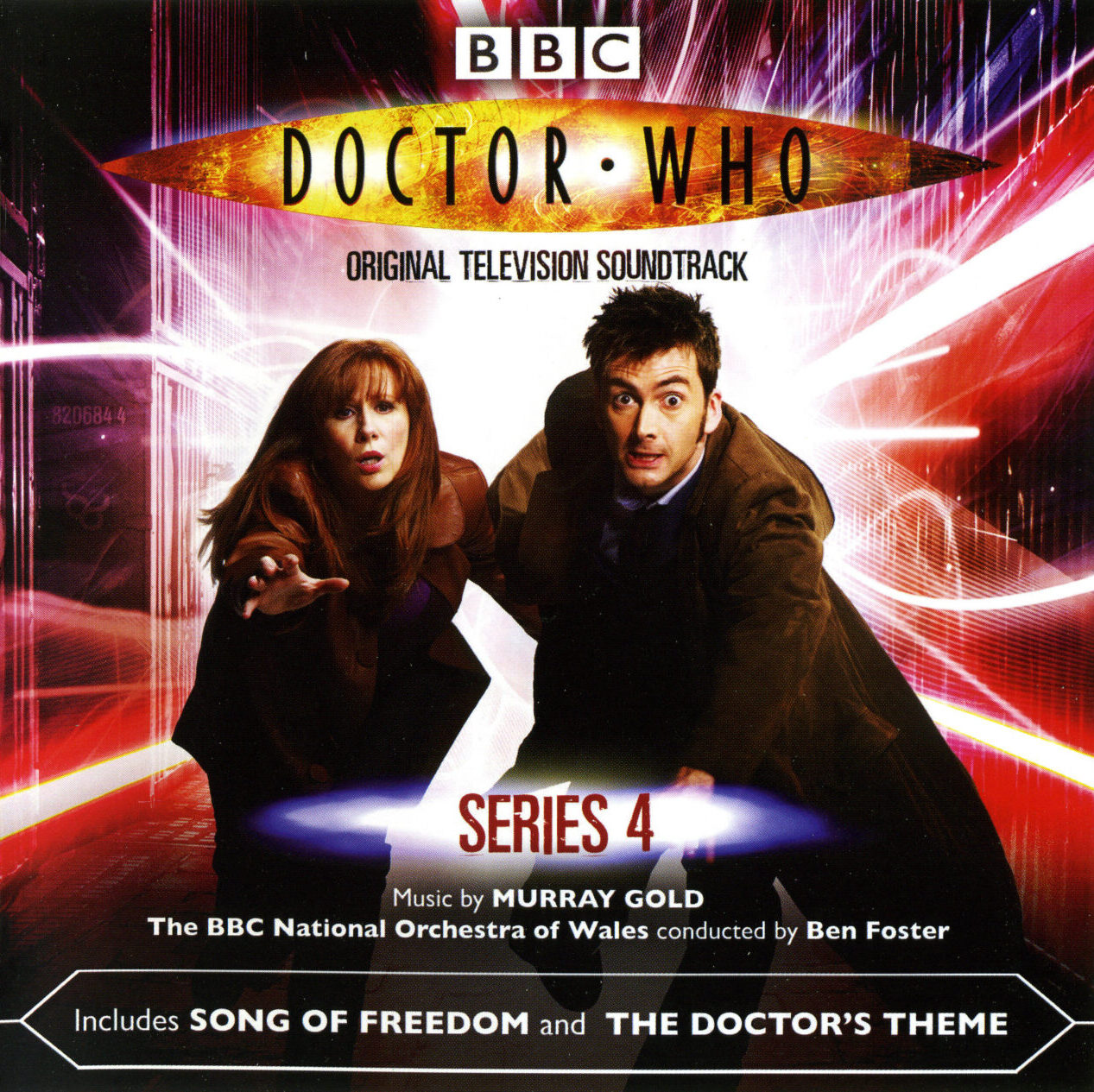
Doctor Who: Series 4 – music by Murray Gold
It just goes to follow that, as I liked season 4 of the new Doctor Who better than season 3, I hold its soundtrack album in a similar regard. In terms of both story and soundtrack, the new Who’s fourth season is everything I wanted – but didn’t get – from the third season, and composer-in-residence Murray Gold delivered music to match the more effective storytelling.
Most of the season’s highlights are represented here, with a wealth of music from Voyage Of The Damned, Silence In The Library / Forest Of The Dead, Turn Left, The Stolen Earth / Journey’s End, and even slightly less obvious gems like Midnight. Voyage is represented by a ten-minute suite of highlights from that expanded, nearly-movie-length Christmas special, while there’s no shortage of music from the season’s two-parters – with one disappointing exception. The Sontaran Stratagem and The Poison Sky sported some suspenseful, brassy music to accompany the attempted invasion by the warlike spuds, only one piece of which – a rehash of the first soundtrack volume’s UNIT theme – shows up here. As fearsome as this two-parter made the Sontarans out to be, their music is notable by its absence here.
Fan favorites such as the Ood songs from Planet Of The Ood (reprised in the climactic moments of Journey’s End), the reverse-echoed rendition of the Doctor’s theme from Turn Left, and even the rapid-fire techno-action piece “Hanging On The Tablaphone” (which, aside from being a play on a Blondie song title, underscored frantic preparations in Torchwood during the finale) can be found here. My favorite surprise is the brutal music from Midnight, truly scary in its intensity (and apparently the composer’s homage to Jerry Goldsmith’s music from Planet Of The Apes). It’s an exhausting listen, even with its just-over-three-minute running time, and really makes you feel like you’ve been beaten up by the end of it. It’s interesting to note that some of the Midnight music – whose howling, descending trombones call to mind Michael Giacchino’s music from Lost – also shows up in the “Davros” track.
 The real question now is: will Murray Gold stay? Several major behind-the-scenes figures are following departing showrunner Russell T. Davies out the door after what has almost certainly been an exhausting four years, and even David Tennant is going to bow out in the last of the 2009 special episodes (airing in place of a full season). Having collaborated on such projects as Second Coming, Torchwood and Queer As Folk with Davies, Murray Gold is definitely a Davies loyalist. It remains to be seen if he’ll follow his boss out the door, though – if I’d been asked a season ago, I would’ve said that it was perhaps time for a chance in the show’s creative and musical directions. But season four was so engrossing that I’d like to see Gold stick around long enough to score some Steven Moffat episodes with the 11th Doctor – and yet at the same time, I’ll admit that I could do with fewer appearances of the “orchestra plus a rock drummer” sound. Time, as always, will tell.
The real question now is: will Murray Gold stay? Several major behind-the-scenes figures are following departing showrunner Russell T. Davies out the door after what has almost certainly been an exhausting four years, and even David Tennant is going to bow out in the last of the 2009 special episodes (airing in place of a full season). Having collaborated on such projects as Second Coming, Torchwood and Queer As Folk with Davies, Murray Gold is definitely a Davies loyalist. It remains to be seen if he’ll follow his boss out the door, though – if I’d been asked a season ago, I would’ve said that it was perhaps time for a chance in the show’s creative and musical directions. But season four was so engrossing that I’d like to see Gold stick around long enough to score some Steven Moffat episodes with the 11th Doctor – and yet at the same time, I’ll admit that I could do with fewer appearances of the “orchestra plus a rock drummer” sound. Time, as always, will tell.
- Doctor Who Season Four Opening Credits (0:46)
- A Noble Girl About Town (2:14)
- Life Among the Distant Stars (2:30)
- Corridors And Fire Escapes (1:12)
- The Sybilline Sisterhood (1:53)
- Songs Of Captivity And Freedom (4:03)
- UNIT Rocks (1:11)
- The Doctor’s Daughter (1:38)
- The Source (3:21)
- The Unicorn And The Wasp (3:11)
- The Doctor’s Theme Season Four (2:47)
- Voyage Of The Damned Suite (10:21)
- The Girl With No Name (2:45)
- The Song Of Song (2:14)
- All In The Mind (1:18)
- Silence In The Library (2:57)
- The Greatest Story Never Told (6:17)
- Midnight (3:07)
- Turn Left (2:20)
- A Dazzling End (2:22)
- The Rueful Fate Of Donna Noble (2:44)
- Davros (2:07)
- The Dark And Endless Dalek Night (3:44)
- A Pressing Need To Save The World (4:55)
- Hanging On The Tablaphone (1:07)
- Song Of Freedom (2:51)
- Doctor Who Season Four Closing Credits (1:07)
Released by: Silva Screen
Release date: 2008
Total running time: 76:27
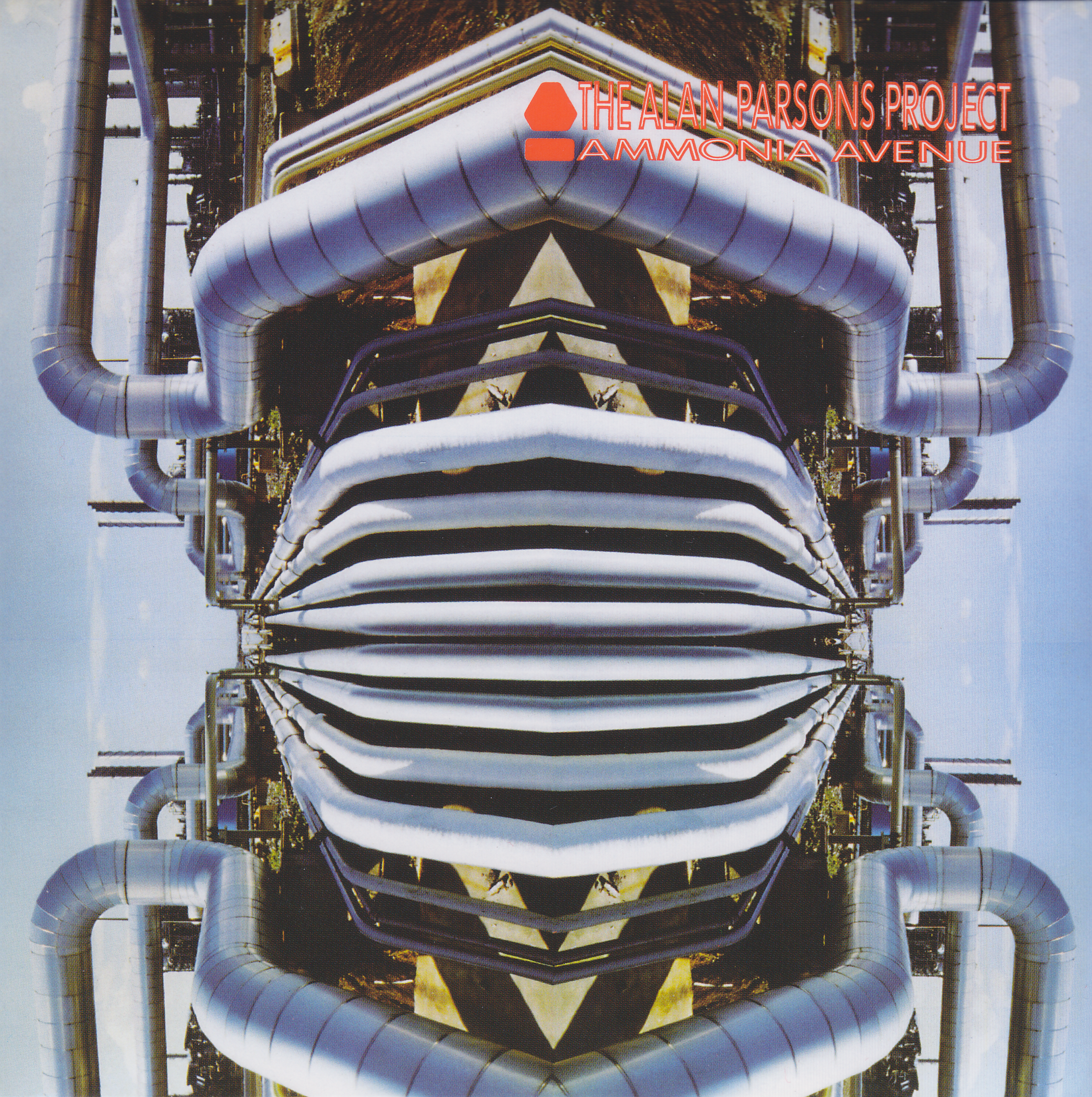
Alan Parsons Project – Ammonia Avenue (remastered)
 At first glance, Ammonia Avenue had everything going for it – some great songs, a band in its prime, and, oh yeah, that whole riding-the-high-of-Eye-In-The-Sky-topping-the-charts thing. How could Alan Parsons, Eric Woolfson & co. possibly go wrong? The answer: studio interference. Ammonia Avenue was a detour into Arista mandating how the group should sound: since Eric Woolfson’s voice graced past Project hits such as “Eye In The Sky” and “Time”, his voice should grace as many songs as possible on the new album.
At first glance, Ammonia Avenue had everything going for it – some great songs, a band in its prime, and, oh yeah, that whole riding-the-high-of-Eye-In-The-Sky-topping-the-charts thing. How could Alan Parsons, Eric Woolfson & co. possibly go wrong? The answer: studio interference. Ammonia Avenue was a detour into Arista mandating how the group should sound: since Eric Woolfson’s voice graced past Project hits such as “Eye In The Sky” and “Time”, his voice should grace as many songs as possible on the new album.
Originally recorded as a double album, Ammonia Avenue was pared down to a single album (with the excised tracks eventually seeing release as the Project’s 1984 album Vulture Culture), and on both Ammonia and Vulture, Eric Woolfson’s nearly-operatic, virginal voice is all over songs that just aren’t suited to it. Even Woolfson has admitted that Arista’s directive put his voice on songs that weren’t originally written for himself. It’s great for “Don’t Answer Me”, Ammonia‘s singular bona fide hit, but “Prime Time” and “One Good Reason” could’ve done with a rockier delivery. Lenny Zakatek, returning here for “You Don’t Believe” and “Let Me Go Home”, would have helped either of those songs tremendously, and Chris Rainbow could’ve done either of them proud too. John Miles is conspicuous by his absence here. Lathering up both albums with a thick coating of Woolfson vocals does a disservice to some otherwise fine songs.
The bonus tracks here offer interesting glimpses into the genesis of songs such as “Don’t Answer Me” and “You Don’t Believe” (which appears here in two forms, the second being a twangy, spaghetti-western-plus-synths instrumental that has to be heard to be believed). As usual, the “added value” tracks will really depend upon how much importance the listener places on hearing the musical equivalent of DVD deleted scenes. If there’s a real standout in the bonus tracks, it’s the rhapsodic minute-and-a-half selection of the orchestral overdub session for “Ammonia Avenue” – I think I like the song better in orchestra-only form than as released!
 Ammonia Avenue was meant to be a great album, a worthy follow-up to Eye In The Sky, and by all rights it should’ve been. The group didn’t let the side down on the songwriting or instrmental performance fronts. But I don’t think it’s an exaggeration to say that the group’s label hastened the demise of the Project by stepping in and demanding a particular vocalist. The beauty of the previous Project albums was that no two songs were alike, not even in vocal delivery; in “normalizing” the range of voices to favor Woolfson, the label took away a lot of the Project’s uniqueness.
Ammonia Avenue was meant to be a great album, a worthy follow-up to Eye In The Sky, and by all rights it should’ve been. The group didn’t let the side down on the songwriting or instrmental performance fronts. But I don’t think it’s an exaggeration to say that the group’s label hastened the demise of the Project by stepping in and demanding a particular vocalist. The beauty of the previous Project albums was that no two songs were alike, not even in vocal delivery; in “normalizing” the range of voices to favor Woolfson, the label took away a lot of the Project’s uniqueness.
- Prime Time (5:03)
- Let Me Go Home (3:21)
- One Good Reason (3:37)
- Since The Last Goodbye (4:35)
- Don’t Answer Me (4:11)
- Dancing On A Highwire (4:23)
- You Don’t Believe (4:26)
- Pipeline (3:57)
- Ammonia Avenue (6:45)
- Don’t Answer Me (early rough mix) (5:09)
- You Don’t Believe (demo) (2:22)
- Since The Last Goodbye (Chris Rainbow vocal overdubs) (0:30)
- Since The Last Goodbye (Eric’s guide vocal rough mix) (4:25)
- You Don’t Believe (instrumental tribute to The Shadows) (3:08)
- Dancing On A Highwire / Spotlight (work in progress) (3:57)
- Ammonia Avenue (Eric’s demo vocal rough mix) (2:42)
- Ammonia Avenue (orchestral overdub) (1:21)
Released by: Sony / Arista
Release date: 1983 (remastered version released in 2008)
Total running time: 63:52
Mike Oldfield – The Songs Of Distant Earth
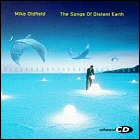 After an extremely acrimonious split with Virgin Records in the early 1990s, multi-instrumentalist Mike Oldfield was already venturing out of Tubular Bells territory throughout the 1980s, dabbling in pop songs (a cover of one of his tunes, “Family Man”, became a hit for Hall & Oates) and mixing music of wildly differing styles and ethnic origins. Virgin mogul Richard Branson was reportedly demanding a Tubular Bells II from Oldfield, who refused to do any such thing, and then released precisely that after switching to Warner Bros. just to give Branson the finger, but a funny thing happened while Oldfield and Branson were battling it out. Other acts started to claim for themselves the instrumental ground which Oldfield had pioneered: Enigma, to name just one example, came to prominence in the early ’90s, and by the time Oldfield got around to releasing this album – which is indeed based on the novel of the same name by the late Arthur C. Clarke – he was having to push his way through a now-crowded musical field.
After an extremely acrimonious split with Virgin Records in the early 1990s, multi-instrumentalist Mike Oldfield was already venturing out of Tubular Bells territory throughout the 1980s, dabbling in pop songs (a cover of one of his tunes, “Family Man”, became a hit for Hall & Oates) and mixing music of wildly differing styles and ethnic origins. Virgin mogul Richard Branson was reportedly demanding a Tubular Bells II from Oldfield, who refused to do any such thing, and then released precisely that after switching to Warner Bros. just to give Branson the finger, but a funny thing happened while Oldfield and Branson were battling it out. Other acts started to claim for themselves the instrumental ground which Oldfield had pioneered: Enigma, to name just one example, came to prominence in the early ’90s, and by the time Oldfield got around to releasing this album – which is indeed based on the novel of the same name by the late Arthur C. Clarke – he was having to push his way through a now-crowded musical field.
Inspired by Clarke’s mention of a musical celebration at the end of “The Songs Of Distant Earth”, Oldfield added “spacey” synths and production textures to his usual structure. Despite boasting a track list which divides things up into shorter, discrete tracks, The Songs Of Distant Earth is classic Oldfield, with lengthy development of a central theme introduced early on, and the introduction and development of secondary themes coming later in the album. It may not sound like Hergest Ridge or Ommadawn, but in fact, Songs shares a very similar structure. Like those albums/pieces (in Oldfield’s case, he composes long pieces with minimal breaks, so these terms are almost interchangeable), there’s almost no interruption from one portion of the music to the next, and Oldfield’s soaring guitar work is an obvious sonic trademark. Now, as someone who climbed onto the Oldfield train by way of his early ’70s work, I’m a little disappointed to hear that his guitar takes a back seat, at times, to synths, various kinds of percussion, ethnic vocals and so on, but one can’t stick to the same formula forever. By that same token, there are spoken word samples of everything from a man counting down, to chants, to the crew of Apollo 8 reading from the book of Genesis, woven into the music; interestingly, depending on what mood I’m in, I’ve found these soundbytes either interesting and relaxing or irritating.
 Songs Of Distant Earth is an interesting experiment in linking music to literature, sort of a soundtrack that bypasses the hurdle of a movie deciding what everything should look/sound like, and it signals a major reinvention on Oldfield’s part. There’s a part of me that loves his older, guitar-heavy work, and finds Songs lacking, but to a more mainstream audience this isn’t a bad place to get your first Oldfield exposure.
Songs Of Distant Earth is an interesting experiment in linking music to literature, sort of a soundtrack that bypasses the hurdle of a movie deciding what everything should look/sound like, and it signals a major reinvention on Oldfield’s part. There’s a part of me that loves his older, guitar-heavy work, and finds Songs lacking, but to a more mainstream audience this isn’t a bad place to get your first Oldfield exposure.
- In The Beginning (1:24)
- Let There Be Light (4:57)
- Supernova (3:23)
- Magellan (4:40)
- First Landing (1:16)
- Oceania (3:19)
- Only Time Will Tell (4:26)
- Prayer For The Earth (2:09)
- Lament For Atlantis (2:43)
- The Chamber (1:48)
- Hibernaculum (3:32)
- Tubular World (3:22)
- The Shining Ones (2:59)
- Crystal Clear (5:42)
- The Sunken Forest (2:37)
- Ascension (5:49)
- A New Beginning (1:37)
Released by: Reprise
Release date: 1994
Total running time: 55:43
Jason Falkner – Bedtime With The Beatles Part Two
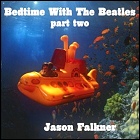 Arriving as a bit of a surprise in between albums of sublime original material, Jason Falkner’s original Bedtime With The Beatles had a curious mandate of its own: recasting Lennon-McCartney classics as lullabyes for little Beatle-fans-to-be. And so help me, it worked – I always thought it was an incredibly relaxing album, but I didn’t realize the true power of it until years later when my own first child came along. Bedtime With The Beatles was a godsend. The arrival of this second volume of Falkner’s lullabye arrangements came out of nowhere too; maybe it’s because I don’t keep up with very many artists via fansites or MySpace or what have you, but I didn’t know it was in the works, and eagerly picked it up, because now I knew how handy it could be. It wasn’t just a matter of my personal tastes for enjoyment – I had a kid who desperately needed some new sleepytime material.
Arriving as a bit of a surprise in between albums of sublime original material, Jason Falkner’s original Bedtime With The Beatles had a curious mandate of its own: recasting Lennon-McCartney classics as lullabyes for little Beatle-fans-to-be. And so help me, it worked – I always thought it was an incredibly relaxing album, but I didn’t realize the true power of it until years later when my own first child came along. Bedtime With The Beatles was a godsend. The arrival of this second volume of Falkner’s lullabye arrangements came out of nowhere too; maybe it’s because I don’t keep up with very many artists via fansites or MySpace or what have you, but I didn’t know it was in the works, and eagerly picked it up, because now I knew how handy it could be. It wasn’t just a matter of my personal tastes for enjoyment – I had a kid who desperately needed some new sleepytime material.
The problem there, however, is that Falkner’s arrangements on this second volume are much more “involved.” Great from an active listening standpoint, but there’s simply too much going on for it to reach quite the same level of relaxation as the first volume. In places – I’m looking at you, “Penny Lane” – Bedtime Part Two almost ceases to by lullabye music and slides its toes adventurously over the line into downtempo lounge arrangements of the Beatles.
That’s not to say that nothing here lives up to the sleepytime potential of the first volume. “She’s Leaving Home” – which was very nearly a lullabye to begin with in its original form – is positively inspired, with “Here Comes The Sun” coming in a close second as my favorite. “Hey Jude” has low-key vocals-as-instruments that really straddle the line between relaxing and active enough that they demand attention. Some songs, such as “Norwegian Wood”, “Something” and “I Will” try very hard to reach for the sound of the original recordings, with more elaborate guitar work or production, and as such they become “active listening” material. With its back-tracked keyboards and chiming guitar chords, I can’t really imagine anyone drifting off to Falkner’s cover of “Norwegian Wood”.
 And what does the little E think? Maybe it was just because it was new music to his ears, combined with his general tendency toward trying to avoid sleep at all costs, but my attempt to introduce him to Bedtime With The Beatles Part Two confirmed my suspicions: he got too involved with listening to it to really relax. But in the end, soft-pedaling my one-year-old into his indoctrination as a potential Beatles listener can’t be all bad – but it’s not all meant for bed either.
And what does the little E think? Maybe it was just because it was new music to his ears, combined with his general tendency toward trying to avoid sleep at all costs, but my attempt to introduce him to Bedtime With The Beatles Part Two confirmed my suspicions: he got too involved with listening to it to really relax. But in the end, soft-pedaling my one-year-old into his indoctrination as a potential Beatles listener can’t be all bad – but it’s not all meant for bed either.
- Norwegian Wood (3:28)
- Something (3:37)
- She’s Leaving Home (4:33)
- Penny Lane (4:27)
- Lucy In The Sky With Diamonds (4:38)
- Here Comes The Sun (3:33)
- I Will (2:07)
- Hey Jude (5:08)
- Yesterday (2:36)
- Good Night (4:54)
Released by: Adrenaline
Release date: 2008
Total running time: 39:01
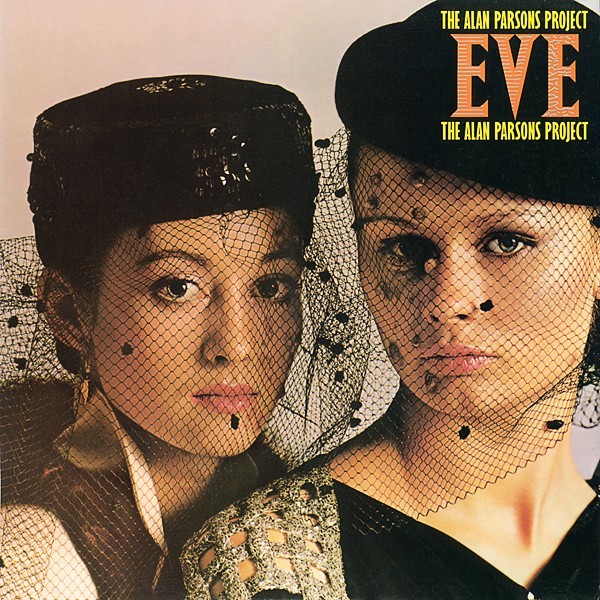
Alan Parsons Project – Eve (remastered)
 One of my favorite Alan Parsons Project albums, Eve is a bit of a “dark horse” for most fans. Indeed, it really is an oddball in the Project canon: the only album (apart from Freudiana, which some fans refuse to count as a Project album) with female lead vocals, and the odd one out of the revolving future/past themes of the Project’s 1970s output. And yet, in breaking with all of the above traditions, Eve showed the Project’s seemingly limitless range, and I was disappointed that the group really didn’t get this adventurous again.
One of my favorite Alan Parsons Project albums, Eve is a bit of a “dark horse” for most fans. Indeed, it really is an oddball in the Project canon: the only album (apart from Freudiana, which some fans refuse to count as a Project album) with female lead vocals, and the odd one out of the revolving future/past themes of the Project’s 1970s output. And yet, in breaking with all of the above traditions, Eve showed the Project’s seemingly limitless range, and I was disappointed that the group really didn’t get this adventurous again.
Remastered until they’re crisp and tasty, the original album tracks have never sounded better – really. “Damned If I Do” is one of my all-time favorite Project singles, and it’s fair to say that I’ve listened to it more than the average bear…and even so, I picked out stuff from the remaster that I’d never heard before, nearly 30 years later.
The bonus tracks start off with something that, for longtime Project fans, has to be close to the Holy Grail: a track from the legendary unreleased album The Sicilian Defence. I apparently had Sicilian misplaced in time; I thought it was recorded in the 1980s, not between Eve and Turn Of A Friendly Card. (Sicilian Defense was an all-instrumental album concocted and delivered by Parsons and Eric Woolfson with the intention of fulfilling and getting out from under their Arista Records contract, and while it did indeed displease the label – as intended – it did result in a contract renegotiation that, fortunately for Arista, kept the Project there for a few more albums which would be the group’s biggest.) “Elsie’s Theme” is the sole Sicilian track to see the light of day on any of the remastered CDs, and it’s a quiet solo piano piece – perhaps not what you were expecting, but almost certainly not what Arista was expecting either.
Following that are demos and intermediate, work-in-progress mixes of such tracks as “Secret Garden”, “Damned If I Do” and “Lucifer”, which – as with most of the Project bonus tracks – are interesting if you’re a diehard fan and/or fascinated with the recording/production process, but whether or not these tracks will hold any real appeal beyond that crowd is the real question. Unlike most of the other Project remasters, Eve at least gives us some “new” music in “Elsie’s Theme”, but a piano instrumental is probably not what Project fans envisioned when thinking of lost treasure bonus tracks.
Eve is a hard sell, even for the group’s biggest fans, and it may well be that those same fans may drool over the Sicilian Defence track and then shrug as the sum total of the bonus tracks. Given that Parsons himself holds The Sicilian Defence in much the same  regard as George Lucas holds the Star Wars Holiday Special, it’s amazing that we got to hear even one track (apparently under considerable pressure from the label, if the liner notes are to be believed), but ultimately the album remains very strong on its own merits. If you already liked Eve (surely I’m not alone there), the remaster is worth the price of admission; if you didn’t, the bonus material is unlikely to sway you.
regard as George Lucas holds the Star Wars Holiday Special, it’s amazing that we got to hear even one track (apparently under considerable pressure from the label, if the liner notes are to be believed), but ultimately the album remains very strong on its own merits. If you already liked Eve (surely I’m not alone there), the remaster is worth the price of admission; if you didn’t, the bonus material is unlikely to sway you.
- Lucifer (5:08)
- You Lie Down With Dogs (3:48)
- I’d Rather Be A Man (3:53)
- You Won’t Be There (3:43)
- Winding Me Up (3:55)
- Damned If I Do (4:52)
- Don’t Hold Back (3:37)
- Secret Garden (4:43)
- If I Could Change Your Mind (5:59)
- Elsie’s Theme From The Sicilian Defence (The Project That Never Was) (3:00)
- Lucifer (demo) (2:48)
- Secret Garden (rough mix) (4:42)
- Damned If I Do (rough mix) (4:46)
- Don’t Hold Back (vocal rehearsal rough mix) (3:43)
- Lucifer (early rough mix) (4:17)
- If I Could Change Your Mind (rough mix) (5:46)
Released by: Sony / Arista
Release date: 1979 (remastered version released in 2008)
Total running time: 68:40
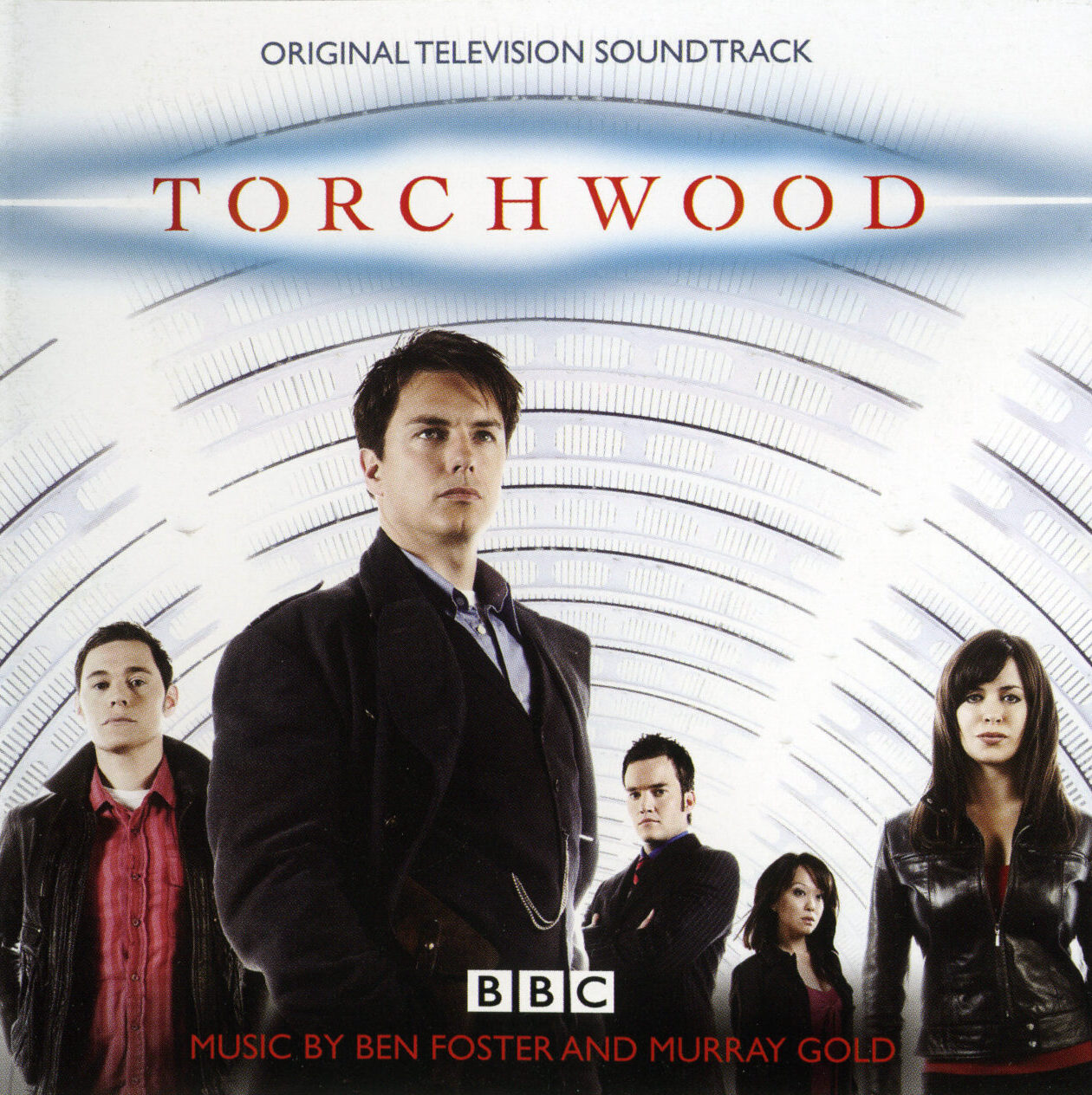
Torchwood – music by Ben Foster & Murray Gold
Featuring the darker, moodier music of Doctor Who’s darker, moodier and decidedly more “adult” spinoff, the Torchwood soundtrack album is full of surprises, but some listeners may be dismayed to find that part of the surprise is what isn’t on it.
From the beginning, Torchwood’s musical score has been the work of two composers, Doctor Who maestro Murray Gold and Ben Foster, who has served as his orchestrator for several years. Foster steps into the limelight here, as the Torchwood CD concentrates almost entirely on his work. However, what this means is that some of the most recognizable pieces of music associated with Torchwood are missing from the album. Many of Gold’s themes, established in the series premiere, were reused throughout season one, and they’re absent from the album, including the drum beat lead-in to the opening teaser (over which John Barrowman explains the show’s premise), and an energetic, pulsating theme that often accompanied the appearance of the team’s trademark black Land Rover in season one. There’s one suite of music from the premiere episode, Everything Changes, and it’s hardly the most striking music from that episode.
What is on the CD is no slouch, mind you; there isn’t anything that’s so bad that I’m reaching for the skip track button. But sometimes it all seems to blend together – there are lengthy stretches of fairly similar music that reach across several tracks. There are some standout cues: “Sleeper”, “Look Right, Then Leave” and the one-two punch of “Jack Joins Torchwood” and “Captain Jack’s Theme” are action-oriented highlights. The best of the lower-key fare includes “Out Of Time”, “Owen’s Theme” and the eerie back-tracked piano work on “Pearl And The Ghost Maker.” Some pieces, like “Into The Hub”, straddle the fence between gentler orchestral music and the show’s trademark electro-inspired action music. A nicely expanded version of the Torchwood theme (which is almost painfully short on TV) rounds out the collection.
Compositionally, there are some incredibly clever things about the music from Torchwood – in the track “Owen Fights Death”, it’s possible to hear how the themes for the various characters are in a common key, making it possible to interweave the themes for Jack and Owen in this track, or the themes for Owen and Toshiko in “Goodbyes”. Toshiko’s theme also finds its way into the extended version of the show’s main theme.
 I can understand that it vastly simplifies things to limit an album to one composer almost exclusively. But the problem here is that there are memorable major themes that have been left out in the cold. Casual fans may not notice…but then again, how many truly casual fans will bother to pick up the soundtrack? Perhaps some of Gold’s compositions should be piggybacked onto a future Doctor Who soundtrack release (particularly the rumored “best of the first four seasons’ music that didn’t make it onto any of the other CDs” album that, like the TARDIS, may or may not materialize), or offered as download-only pieces; without his work from the first season, as nice as Foster’s music is, the Torchwood CD just seems to be missing something.
I can understand that it vastly simplifies things to limit an album to one composer almost exclusively. But the problem here is that there are memorable major themes that have been left out in the cold. Casual fans may not notice…but then again, how many truly casual fans will bother to pick up the soundtrack? Perhaps some of Gold’s compositions should be piggybacked onto a future Doctor Who soundtrack release (particularly the rumored “best of the first four seasons’ music that didn’t make it onto any of the other CDs” album that, like the TARDIS, may or may not materialize), or offered as download-only pieces; without his work from the first season, as nice as Foster’s music is, the Torchwood CD just seems to be missing something.
- Everything Changes (1:24)
- The Chase (3:28)
- Ghosts (2:00)
- Sleepers, Awake! (1:14)
- Toshiko And Tommy (3:09)
- Into The Hub (2:08)
- The Mission (2:36)
- Gray’s Theme (2:45)
- Jack’s Love Theme (1:53)
- Another Day, Another Death (2:48)
- Look Right, Then Leave (2:50)
- Welcome To Planet Earth (1:54)
- The Plot (3:25)
- Out Of Time (1:31)
- The Death Of Dr. Owen Harper (2:13)
- King Of The Weevils (4:12)
- Owen Fights Death (1:52)
- The Woman On The Roof (2:26)
- Owen’s Theme (3:13)
- Pearl And The Ghostmaker (2:28)
- Flat Holm Island (2:12)
- A Boy Called Jonah (4:55)
- Toshiko Sato: Betrayal And Redemption (3:49)
- Gwen And Rhys (1:15)
- Jack Joins Torchwood (1:37)
- Captain Jack’s Theme (3:20)
- I Believe In Him (1:34)
- Memories Of Gray (2:32)
- Goodbyes (2:23)
- The Death Of Toshiko (2:23)
- The End Is Where We Start From (2:28)
- Torchwood Theme (1:36)
Released by: Silva Screen
Release date: 2008
Total running time: 79:33
Art Of Noise – And What Have You Done With My Body, God?
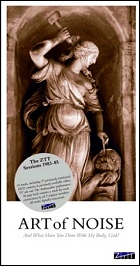 A fascinating peek into the early archives of Art Of Noise, this four-disc box set chronicles not only the process by which the group’s seminal debut album was shaped, but it also shows the group struggling to define precisely what their sound would be, with numerous dead-end turns, cul-de-sacs and non-sequiturs along the way before they arrived at an answer which would almost single-handedly define an entire genre of music.
A fascinating peek into the early archives of Art Of Noise, this four-disc box set chronicles not only the process by which the group’s seminal debut album was shaped, but it also shows the group struggling to define precisely what their sound would be, with numerous dead-end turns, cul-de-sacs and non-sequiturs along the way before they arrived at an answer which would almost single-handedly define an entire genre of music.
The only problem with this fascinating study of that first album is this: And What Have You Done With My Body, God? presents slight variations, retakes, outtakes and rejects of the same handful of songs…over and over again. If there was ever a collection for which the phrase “for the die-hard fans only” was coined, this would be it. In particular, you’d better like “Close (To The Edge)” and “Beatbox (Diversion One)”. A lot. Because you’ll be hearing them…a lot. And I’m not exaggerating there, really – the entirety of this four-disc set is devoted to the making of the first album. I could see, perhaps, four discs devoted to outtakes, rejects and rarities from the band’s entire career, but no – this is all about the first album.
That’s not to say that it isn’t fascinating stuff, provided that you’re well acquainted with that album. I was quite intrigued with all of the alleyways that “Close (To The Edit)” nearly got lost in on its way to becoming a defining musical moment of the 1980s. Bland synth pads, different samples and even bits and pieces that became attached to other Art Of Noise songs later on were tried on and discarded. A few neat ideas were too, but for the most part, one quickly gains an understanding of why these versions didn’t make the final cut. “Beatbox (Diversion One)” goes through a similar evolution, though for most of its development it bears a slightly stronger resemblance to its final version.
There are other songs here that simply didn’t make it to the first album; some of them – like “Bright Noise”, “Flesh In Armour” and the brilliant but short piece “Comes And Goes” – would surface early in the band’s career on EPs and as B-sides, but others were left by the side of the road, sometimes with good reason. There are several attempts at a song built around a sample of a man singing “ain’t no goodbye” over and over again; not only is the song itself maddening, but one increasingly gets a whiff of the frustration that must have been felt by the group: this just isn’t working.
 For the uninitiated listener who doesn’t have Who’s Afraid Of? (The Art Of Noise) memorized front to back, however, this box set may seem unfocused, repetitive and confusing at best. Those looking to get into Art Of Noise would do better to pick up the actual album whose making this set covers, and then come back to this box set at a later date. The sticker on the front promises that this set is “The ZTT Years” – the label on which AON started out – and my only advice is that, should a second set follow, it should spread its wings a bit and perhaps cover the remainder of the group’s output for the 1980s in one go, because even for a fan, this set’s narrow focus on one album can get a bit wearing.
For the uninitiated listener who doesn’t have Who’s Afraid Of? (The Art Of Noise) memorized front to back, however, this box set may seem unfocused, repetitive and confusing at best. Those looking to get into Art Of Noise would do better to pick up the actual album whose making this set covers, and then come back to this box set at a later date. The sticker on the front promises that this set is “The ZTT Years” – the label on which AON started out – and my only advice is that, should a second set follow, it should spread its wings a bit and perhaps cover the remainder of the group’s output for the 1980s in one go, because even for a fan, this set’s narrow focus on one album can get a bit wearing.
Disc One: The Very Start Of Noise
- Beat Box (One Made Earlier) (2:19)
- Once Upon A Lime (3:21)
- War (Demo 2) (1:27)
- Close To The Edge (2:19)
- Confession (1:02)
- Moments In Love (7:52)
- Sign On Relief (1:28)
- Who’s Afraid Of Scale? (4:36)
- So What Happens Now (Take 2) (4:23)
- The Subject Has Moved Left (1:44)
- It’s Not Fair (4:28)
- Close To The Edge (Ruff Mix) (5:54)
- A Time For Fear (Who’s Afraid) (4:33)
- Moments In Bed (6:12)
- Hidden Track (0:55)
Disc Two: Found Sounds and Field Trips
- Moments In Love (12″ B-Side Idea) (3:10)
- Tears Out Of A Stone (2:56)
- Samba #2 (0:39)
- The Chain Of Chance (4:36)
- Fairlight-In-The-Being (4:37)
- Diversions 3 (3:53)
- Close (To Being Compiled) (3:47)
- Diversions 5 (3:46)
- Damn It All (1:42)
- Structure (1:13)
- The Angel Reel: Hymn 1 (Take 2) (0:36)
- The Angel Reel: Hymn 3 (1:20)
- The Angel Reel: Fairground (0:43)
- And What Have You Done With My Body, God? (4:40)
- Klimax (1:48)
- Who Knew? (2:36)
Disc Three: Who’s Afraid Of Goodbye?
- War (Demo) (4:39)
- The Focus Of Satisfaction (11:02)
- Moments In Love (rejected 7″) (3:44)
- It Stopped (4:27)
- The Uncertainty Of Syrup (1:21)
- The Long Hello (4:34)
- The Vacuum Divine (0:47)
- The Ambassadors Reel: Beat Box (3:54)
- The Ambassadors Reel: Medley (10:56)
- The Ambassadors Reel: Oobly (1:21)
- Goodbye Art Of Noise (0:37)
- Hidden Track (1:06)
Disc Four: Extended Play
- Battle (0:27)
- Beat Box (4:49)
- The Army Now (2:03)
- Donna (1:45)
- Moments In Love (5:11)
- Bright Noise (0:05)
- Flesh In Armour (1:24)
- Comes And Goes (1:19)
- Moment In Love (1:27)
- That Was Close (20:44)
- Moments In Love (from Battle to Beaten) (14:28)
- In Case We Sneezed (0:31)
- A Time To Hear (Who’s Listening) (3:32)
- Do Donna Do (3:12)
- Hidden Track (0:25)
Released by: ZTT
Release date: 2006
Disc one total running time: 52:33
Disc two total running time: 42:02
Disc three total running time: 48:27
Disc four total running time: 61:22
Stargate: Continuum – music by Joel Goldsmith
 Released hot on the heels of the direct-to-DVD movie, Joel Goldsmith’s epic score from Stargate: Continuum is, not unlike the movie it accompanies, even bigger and better than Ark Of Truth. Continuum is a story painted on a broader canvas, and the music follows suit – in places, it’s positively epic stuff, in the tradition of John Williams and, yes, a certain other film composer named Goldsmith.
Released hot on the heels of the direct-to-DVD movie, Joel Goldsmith’s epic score from Stargate: Continuum is, not unlike the movie it accompanies, even bigger and better than Ark Of Truth. Continuum is a story painted on a broader canvas, and the music follows suit – in places, it’s positively epic stuff, in the tradition of John Williams and, yes, a certain other film composer named Goldsmith.
The score opens with a spacious new rendition of David Arnold’s Stargate theme (hearkening back to the original movie) and then segues into a jaunty, lighthearted piece as the team assembles for their next mission. We’re then treated to the choral dirge heard as the list of Ba’al’s crimes is read prior to his execution; while the choir was heard in the Ark Of Truth soundtrack, it’s used more, and to better effect, here. “The Last Of The System Lords” is the first of several bold action cues that almost feel as much like Star Wars as they do Stargate – it’s big, widescreen music.
Even in its more contemplative moments – such as the very relaxing “Endless Horizons” and “Breaking The Ice” – the music is panoramic. The Arctic Circle footage is lovely, yes, but Goldsmith’s music really helps to sell the setting, especially as a pretty good chunk of that part of the movie is dialogue-free. “Endless Horizons” is a nice accompaniment to that rather bleak travelogue.
 With the recent announcement that the faltering spinoff series Stargate Atlantis is moving out of weekly production and into movies like the SG-1 direct-to-DVD adventures, I’m actually somewhat pleased…because maybe Joel Goldsmith will get to make more music like this, and more CDs to go along with it. As a fan of his music for this particular franchise, that suits me just fine.
With the recent announcement that the faltering spinoff series Stargate Atlantis is moving out of weekly production and into movies like the SG-1 direct-to-DVD adventures, I’m actually somewhat pleased…because maybe Joel Goldsmith will get to make more music like this, and more CDs to go along with it. As a fan of his music for this particular franchise, that suits me just fine.
- A Day At SGC (3:41)
- The List (1:19)
- Murder Of Untold Millions (1:46)
- The Achilles Commandeered (1:21)
- The Last Of The System Lords (6:29)
- For The Good Of Others (0:47)
- The Sinking Of The Achilles (0:44)
- Endless Horizons (2:06)
- Breaking The Ice (2:11)
- New Identities (2:27)
- Ba’al Divided (0:54)
- Bring A God To Tears (1:20)
- Daniel’s Book (1:31)
- Al’Kesh Invasion (0:54)
- Photograph (0:50)
- Apophis (3:43)
- The Armada (1:24)
- Quetesh Takes Over (3:07)
- Battle Over The Ocean (2:19)
- The Machine (1:51)
- Fall Of The Heroes (2:35)
- End Of The Reign (2:25)
- The Extraction (2:06)
- O’Neill Buys Lunch / End Title (4:46)
Released by: Free Clyde Music
Release date: 2008
Total running time: 52:36
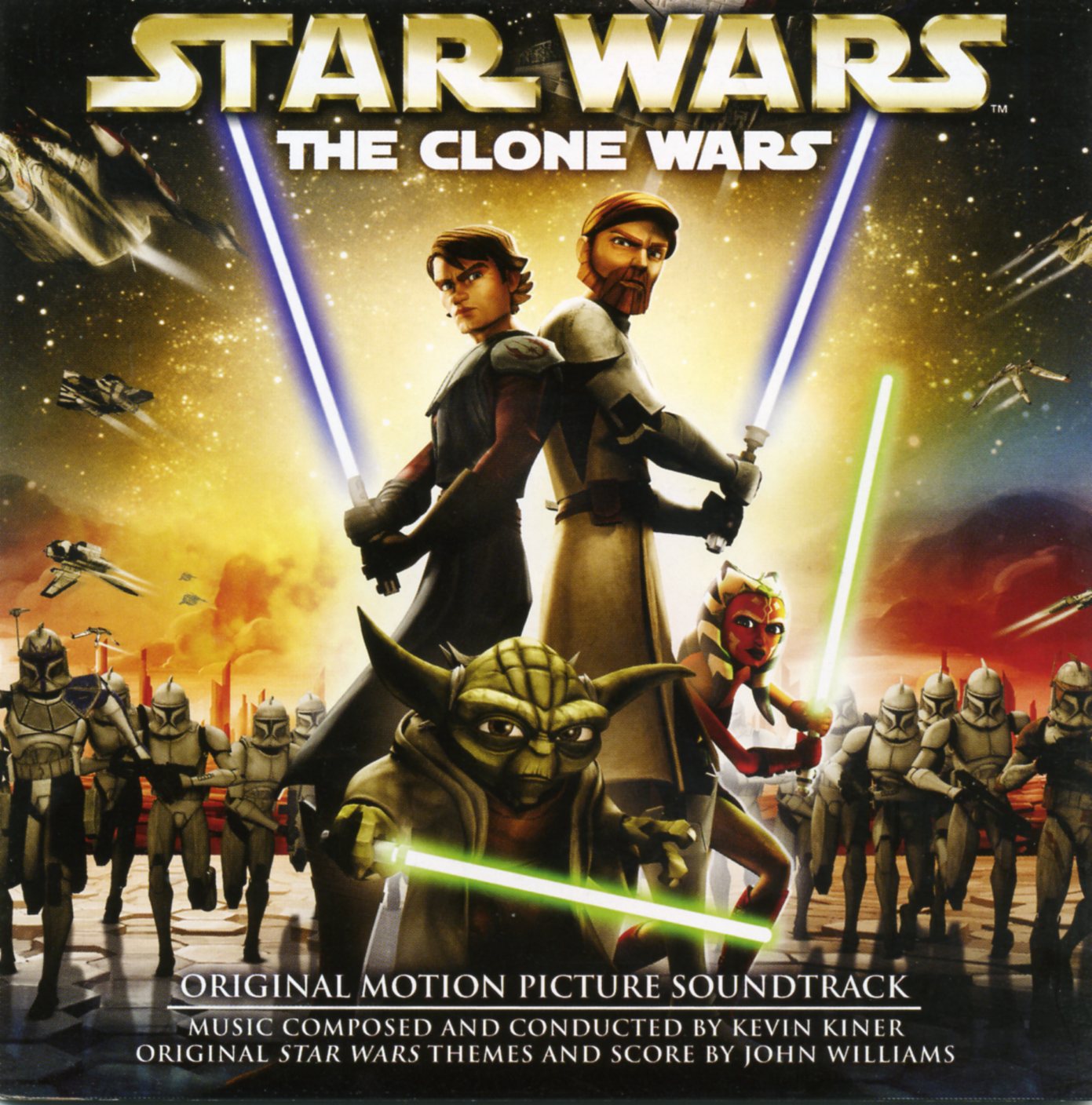
Star Wars: The Clone Wars – music by Kevin Kiner
 Having reviewed the music from nearly the entire prequel trilogy “sight unseen” (i.e. without seeing the movie first), I thought I could get away with it again here, with the soundtrack to the CG-animated movie The Clone Wars. It may turn out that this wasn’t a good idea, because the soundtrack is as much a departure from everything that has gone before it as the film itself.
Having reviewed the music from nearly the entire prequel trilogy “sight unseen” (i.e. without seeing the movie first), I thought I could get away with it again here, with the soundtrack to the CG-animated movie The Clone Wars. It may turn out that this wasn’t a good idea, because the soundtrack is as much a departure from everything that has gone before it as the film itself.
What sets The Clone Wars apart from the prequel and original trilogies is that it was done entirely in the computer. One could argue that no camera ever rolled on large chunks of Episode II and Episode III as well, but with Clone Wars there’s not even a pretense of photorealism – the characters are now seen in a stylized, animé-inspired light, and the only actors involved are voice actors. It would seem that the entirely-computer-generated scenes of the prequel trilogy were just a stepping stone.
The music marks a significant departure from the rest of the saga as well. For one of the very few times in the Star Wars franchise’s history, it has been decided to go with a composer other than John Williams, although of course the new maestro may make use of Williams’ themes from time to time. In this case, the new musical voice of Star Wars is provided by Kevin Kiner, who has scored several films and TV shows on his own (such as the Leprechaun movies and Stargate SG-1), and served a vital role in the final season of Star Trek: Enterprise when the show’s budget cuts forced its composers to fall back on synths and samples instead of real orchestral instruments; Kiner teamed up with longtime Trek composer Dennis McCarthy and fleshed out McCarthy’s music into synth-orchestral life. The best example of this available on record may be on McCarthy’s privately-released Star Trek: Borg soundtrack, whose last three tracks are explosive, memorable stuff that you’d swear was performed by a huge ensemble. Kiner is, in fact, that good.
But from the first moments of music on the Clone Wars soundtrack, it’s clear that the musical vocabulary of Star Wars is changing along with the visual vocabulary. The music is a complete departure from the traditional opening of a Star Wars film, and though Williams’ immortal theme tune is quoted, it’s quoted in an unfamiliar context. For those of us who are rushing toward (or past) the age of 40 like the Millennium Falcon making the Kessel Run, it could be seen as a sign that this isn’t our Star Wars anymore – this is Star Wars for our kids.
Nowhere is that more evident than in the early track “Obi-Wan To The Rescue”, which breaks right out of the romantic-orchestral mode into a staccato barrage of electric guitar. To be fair, screaming guitars could be heard woven into the orchestral textures of Episode II‘s wild chase through the “streets” of Coruscant, but here, it’s front and center, and instead of being an exotic flavoring, it’s rock ‘n’ roll. Similarly, tracks such as “Ziro’s Nightclub Band” and “Seedy City Swing” don’t attempt to view earthly music through a somewhat alien prism (a la Williams’ “Cantina Band” cues) – they’re on-the-nose earthly music with no pretensions of being anything but. Given that this installment of the franchise – and it subsequent TV incarnation, which will also be scored by Kiner – seems to be aimed at a younger audience, I’m not saying that these more traditional, not-so-otherworldly treatments are bad. They server their purpose as a kind musical shorthand for the action they accompany.
And yet, with cues like “Destroying The Shield”, you’d swear Williams was at the conductor’s podium – Kiner’s original pieces, for the most part, do not sound out of place next to the rest of the saga. This is partly why I listened to the soundtrack before seeing the movie: I wanted to see if the music would work just fine if there were real actors on the screen in costume. It’s not like this is John Williams meets Carl Stalling. There’s nothing I can think of that stands out as “cartoon music.” Slightly cliched bits of source music? Sure. Maybe all of a couple of minutes’ worth. This is why we have “next track” buttons.
Those expecting wholesale use of Williams’ themes all over the place, however, may be surprised – Kiner develops his own themes across the board, and while there are occasionally hints of the musical signatures originated by Williams, you don’t get big, obvious quotations of the original Star Wars themes until the very end, when some really neat variations on “The Imperial March” and the Ben Kenobi/Force theme roll out. By this time, you’ve grown so accustomed to not hearing a lot of the Williams material that their appearance comes as a shock, which is a neat effect.
Fans of Star Wars music will probably square off along a love/hate battle line to which no skirmish between clones and battle droids can compare when it comes to this album. With its orchestral-plus-occasional-rock-and-techno-beats style, this is post-Matrix Star Wars music. Oddly enough, fans who have already had their palates cleansed in advance by some of the better Star Wars game music of the past 10 years, from Force Commander’s rockin’ remixes to Empire At War’s stew of original material and Williams quotations, will be primed for this approach; those who have stuck to nothing but the original six film scores may be shocked.
 The story of Star Wars, and its music, are under new management (though with George Lucas standing over everyone’s shoulder, clearly with the approval of the old guard), making new Star Wars stories for a new audience. And going by this first installment, there really isn’t anything necessarily wrong with that. It’s cracking good adventure movie music with a few nods back to some old favorites. Star Wars was such a boon to my generation when we were in our single digits – it single-handedly got me fascinated with the visual medium, orchestral music, and the concept of space as a whole, all of which have stayed with me my entire life. So even if this is the sound of Star Wars for our kids…that’s cool. They should be so lucky to have that same kind of inspiration.
The story of Star Wars, and its music, are under new management (though with George Lucas standing over everyone’s shoulder, clearly with the approval of the old guard), making new Star Wars stories for a new audience. And going by this first installment, there really isn’t anything necessarily wrong with that. It’s cracking good adventure movie music with a few nods back to some old favorites. Star Wars was such a boon to my generation when we were in our single digits – it single-handedly got me fascinated with the visual medium, orchestral music, and the concept of space as a whole, all of which have stayed with me my entire life. So even if this is the sound of Star Wars for our kids…that’s cool. They should be so lucky to have that same kind of inspiration.
- A Galaxy Divided (1:13)
- Admiral Yularen (0:56)
- Battle Of Christophsis (3:19)
- Meet Ahsoka (2:44)
- Obi-Wan To The Rescue (1:24)
- Sneaking Under The Shield (4:24)
- Jabba’s Palace (0:46)
- Anakin Vs. Dooku (2:18)
- Landing On Teth (1:43)
- Destroying The Shield (3:08)
- B’omarr Monastery (3:10)
- Battle Strategy (3:07)
- The Shield (1:36)
- Battle Of Teth (2:45)
- Jedi Don’t Run! (1:22)
- Obi-Wan’s Negotiation (2:07)
- The Jedi Council (2:04)
- Ahsoka (3:39)
- Jabba’s Chamber Dance (0:42)
- Ziro Surrounded (2:20)
- Scaling The Cliff (0:46)
- Ziro’s Nightclub Band (0:53)
- Seedy City Swing (0:34)
- Escape From The Monastery (3:12)
- Infiltrating Ziro’s Lair (2:21)
- Courtyard Fight (2:41)
- Dunes Of Tatooine (2:00)
- Rough Landing (3:03)
- Padme Imprisoned (0:50)
- Dooku Speaks With Jabba (1:28)
- Fight To The End (3:59)
- End Credits (0:51)
Released by: Sony Classical
Release date: 2008
Total running time: 67:23
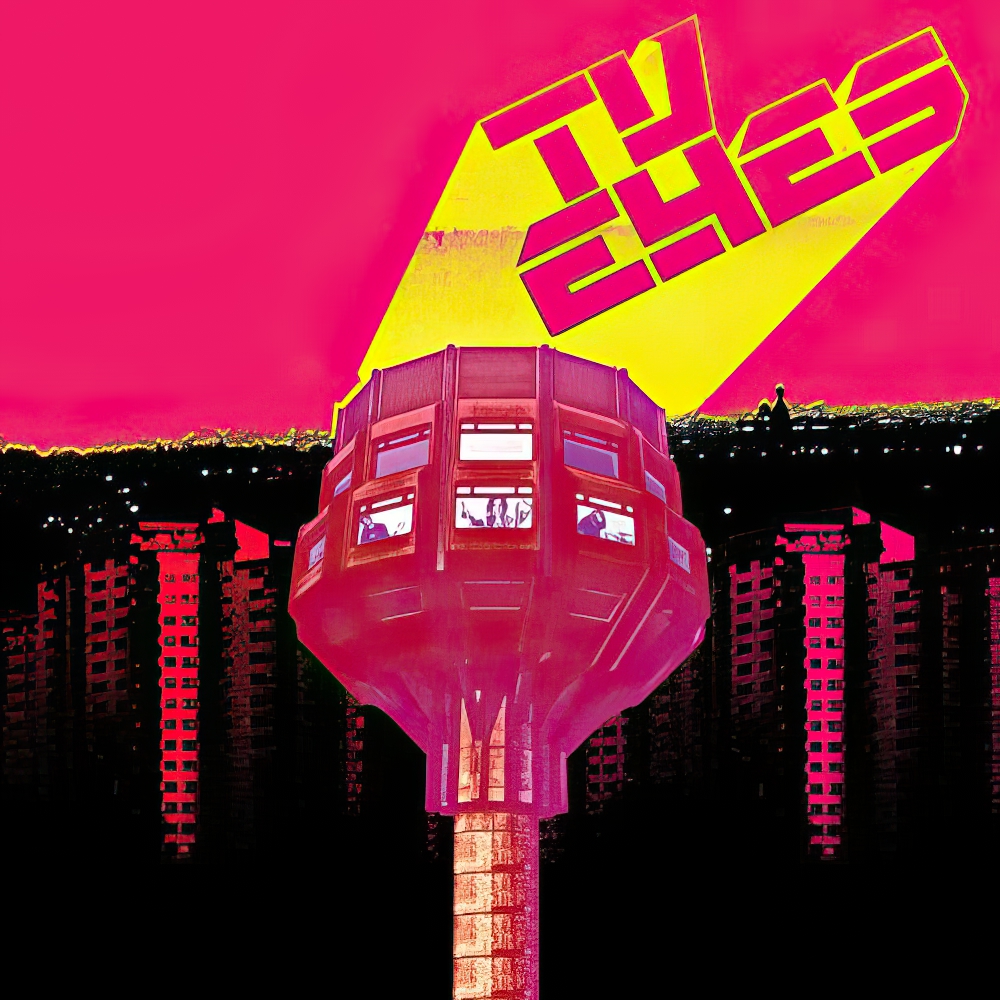
TV Eyes
 Another project from the trio that brought us the bizarre soundtrack-to-a-nonexistent-movie Logan’s Sanctuary, TV Eyes is nothing less than an ’80s revival band that’s playing brand new songs instead of new wave covers. If anything, it’s more of a stylistic tribute to the early ’80s than anything – in some of the songs, you catch a hint of Duran Duran here, a snippet of Kajagoogoo there, and so on. TV Eyes doesn’t use those bands’ songs, but it does appropriate some of their stylistic maneuvers.
Another project from the trio that brought us the bizarre soundtrack-to-a-nonexistent-movie Logan’s Sanctuary, TV Eyes is nothing less than an ’80s revival band that’s playing brand new songs instead of new wave covers. If anything, it’s more of a stylistic tribute to the early ’80s than anything – in some of the songs, you catch a hint of Duran Duran here, a snippet of Kajagoogoo there, and so on. TV Eyes doesn’t use those bands’ songs, but it does appropriate some of their stylistic maneuvers.
The result is a delirious trip right back to the ’80s – I’d almost swear that this is just some 25-year-old album that I’ve never heard before. Standouts include the unabashed ’80s flashback that is the Falkner-penned “She’s A Study”, whose synth arpeggios bring vintage synth-heavy acts such as Level 42 and Orchestral Manoeuvres In The Dark immediately to mind. Falkner’s also responsible for “Mission: Submission”, a throwback to some of the style of Gary Numan, with lyrics that are pure ’80s material, predicting a world run by computers, and the least synth-oriented song on the entire album, “The Party’s Over”, a Clash-esque rocker with political overtones that are vague enough to be from any era and yet directly address the 2000s.
“Over The City” and “Need To Love” shamelessly sound more like the Duran Duran that everyone remembers than Duran Duran itself does these days. My first impression was that it was a little too “drum ‘n’ bass” modern to fit the stylistic parameters of the album, but the rapid-fire keyboard work and funky bassline seals the deal even before the startlingly LeBon-esque vocals kick in. “She Gets Around” is a dance number with a hypnotic synth loop, while “What She Said” is an ode to that oddity of the ’80s, a non-rap song with spoken lyrics.
All of it adds up to one of the most repeat-listen-worthy CDs I’ve come across in years. This stuff is just impossible to get out of your head – it’s that catchy. It’s got a knack for sounding so familiar that you’d think that you’ve been hearing these songs on countless ’80s compilations down through the years, and yet the album – and the songs – are only a couple of years old as of this writing.
 TV Eyes’ debut album is a dandy, and it’s a testament to the sad state of musical tastemaking on this side of the world that this group could only find a label in Japan. (Two of its members, Jellyfish alumni Roger Manning and Jason Falkner, have also released music in Japan that’s unavailable here except as wallet-stranglingly expensive imports.) Someone in America, anyone: pick these guys up, pronto. They really “get” what was so good about some of the music of the 1980s.
TV Eyes’ debut album is a dandy, and it’s a testament to the sad state of musical tastemaking on this side of the world that this group could only find a label in Japan. (Two of its members, Jellyfish alumni Roger Manning and Jason Falkner, have also released music in Japan that’s unavailable here except as wallet-stranglingly expensive imports.) Someone in America, anyone: pick these guys up, pronto. They really “get” what was so good about some of the music of the 1980s.
- Fade Away (4:33)
- She’s A Study (4:55)
- Fascinating (5:20)
- Love To Need (4:05)
- The Party’s Over (4:42)
- What She Said (4:14)
- Over The City (5:00)
- Mission: Submission (4:30)
- She Gets Around (5:22)
- Time’s Up (4:45)
Released by: Phantom
Release date: 2006
Total running time: 48:26
Daniel Gannaway – Joined Like Notes
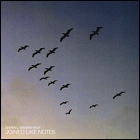 Another EP-sized collection of tunes from indie singer/songwriter Daniel Gannaway, Joined Like Notes brings us a few numbers that either came after his last releases, Summer Storm and Heading For Country, or didn’t quite meet those two collections’ stylistic parameters. With no such limits placed on it (i.e. a “country” feel or every song involving ukelele), Joined Like Notes is a bit more free-form.
Another EP-sized collection of tunes from indie singer/songwriter Daniel Gannaway, Joined Like Notes brings us a few numbers that either came after his last releases, Summer Storm and Heading For Country, or didn’t quite meet those two collections’ stylistic parameters. With no such limits placed on it (i.e. a “country” feel or every song involving ukelele), Joined Like Notes is a bit more free-form.
Songs such as “Mail Order Catalogue” and “A Babe In My Mama’s Arms” hearken back to his earlier works – sparse and yet atmospheric and moody – while “Hurricane Proof (Katrina)” and “Save Trestles (Sediment Flow)” take the opportunity to get topical. “Save Trestles” graced the artist’s MySpace page for quite a while before finally getting this release, and it’s aways been a catchy, toe-tapping number; getting the opportunity to hear it more clearly reveals it to be this CD’s standout. “A Slip In The Grey” and the title track are also stripped-down marvels of mood, with the former sporting some really interesting vocal work in the chorus. “Joined Like Notes” is more uplifting and mesmerizing in its own way.
 Despite a thematic or stylistic angle to the songs on Joined Like Notes, it’s a nice breath of fresh air and a relaxing listen – even with the slightly soft-pedaled protest songs in (though they join a long tradition of folk protest songs in that regard). Highly recommended.
Despite a thematic or stylistic angle to the songs on Joined Like Notes, it’s a nice breath of fresh air and a relaxing listen – even with the slightly soft-pedaled protest songs in (though they join a long tradition of folk protest songs in that regard). Highly recommended.
- A Babe In My Mama’s Arms (3:08)
- Hurricane Proof (Katrina) (4:09)
- Save Trestles (Sediment Flow) (3:09)
- Mail Order Catalogue (3:57)
- A Sip In The Grey (4:08)
- Joined Like Notes (4:09)
Released by: Daniel Gannaway
Release date: 2008
Total running time: 22:40
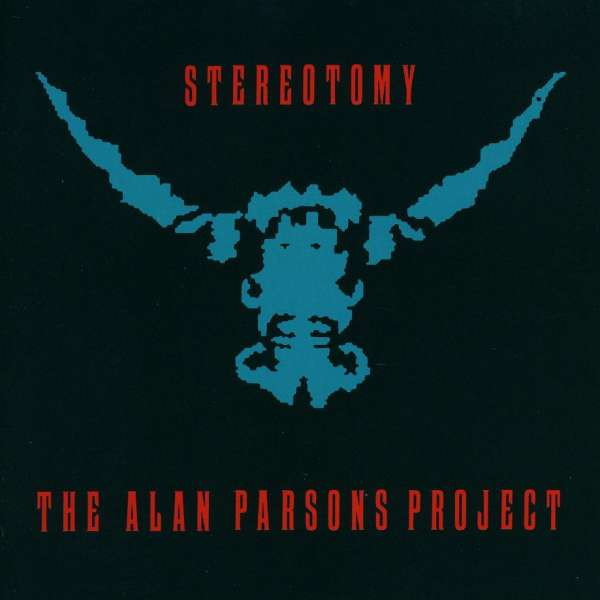
Alan Parsons Project – Stereotomy (remastered)
 Released in 1985, and carefully crafted to fit in snugly with the post-new-wave synth-rock sound of the day, I’ll confess up front that the Alan Parsons Project’s Stereotomy, after all these years, remains my least favorite of the group’s string of albums from the 1970s and ’80s. Of all the Project albums, Stereotomy has almost no discernable theme, breaking a long string of nicely-thought-out concept albums, and at least two of its songs – the title track and the rambling instrumental “Where’s The Walrus?” (a title reportedly coined by an associate of the band complaining that the album didn’t sport anything as instantly catchy as “I Am The Walrus”, and you know, he was right!) – just waffle on too long for the sake of being too long, and long after the band had shed most of its prog rock credibility in exchange for short, catchy singles too.
Released in 1985, and carefully crafted to fit in snugly with the post-new-wave synth-rock sound of the day, I’ll confess up front that the Alan Parsons Project’s Stereotomy, after all these years, remains my least favorite of the group’s string of albums from the 1970s and ’80s. Of all the Project albums, Stereotomy has almost no discernable theme, breaking a long string of nicely-thought-out concept albums, and at least two of its songs – the title track and the rambling instrumental “Where’s The Walrus?” (a title reportedly coined by an associate of the band complaining that the album didn’t sport anything as instantly catchy as “I Am The Walrus”, and you know, he was right!) – just waffle on too long for the sake of being too long, and long after the band had shed most of its prog rock credibility in exchange for short, catchy singles too.
So does Stereotomy reveal anything new in remastered form? Maybe. I’m still a bit underwhelmed by the original album program, and this time around, even the bonus features are a bit thin, with the liner notes booklet pointing out that Parsons had gone to all-digital recording by this time, which made it easier – and, due to the expensive nature of the equipment and recording media, necessarily more economical – to just roll back over outtakes rather than hanging on to them. As a result, most of what we get here are the same songs we already know, except either with no vocals or with an early guide vocal long since mixed out of the released version. There’s one legitimately new song here, “Rumour Goin’ Round”, which is an interesting rock number not too far from the sound of “In The Real World”. It has no lyrics, so it’s presented here as a bit of a rough-hewn instrumental, and one wonders what the finished product would have been like. The liner notes point out that Parsons and songwriter Eric Woolfson felt that the album was full and ready to deliver to the label without finishing out this song, and I’m not entirely sure I agree with that. In any case, as it appears here, it’s not exactly the undiscovered gem that “No Answers Only Questions” was.
I was hoping for some mention of the infamous unreleased ’80s instrumental album The Sicilian Defense, and the controversy which surrounded it as Parsons and Woolfson tried to get out from under their demanding Arista contract, but the liner notes of these releases have steadfastly stayed away from that topic, despite this being a perfect opportunity to separate fact from rumor (were the Sicilian songs mined as material for later albums, or is there really an entire Project album we’ve never heard?), and that whole vetted-by-the-label safe approach has left me disappointed. The liner notes booklets in the Project remasters play it very safe, and even recycle the same liner notes about the post-Project careers of Parsons and Woolfson, word for word. It’s not like Sony’s ELO remaster series opened the vaults and told all in its accompanying literature, but at least one didn’t get the sense that those essays were being phoned in; here, one gets precisely that impression.
 Stereotomy, even in shiny remastered form, doesn’t get out from under the position of being my least favorite Alan Parsons Project album, and truth be told, it’s one of the weakest remasters from a standpoint of bonus material too, making it a completists-only item.
Stereotomy, even in shiny remastered form, doesn’t get out from under the position of being my least favorite Alan Parsons Project album, and truth be told, it’s one of the weakest remasters from a standpoint of bonus material too, making it a completists-only item.
- Stereotomy (7:16)
- Beaujolais (4:28)
- Urbania (5:00)
- Limelight (4:38)
- The Real World (4:21)
- Where’s The Walrus? (7:33)
- Light Of The World (6:17)
- Chinese Whispers (1:01)
- Stereotomy II (1:23)
- Light Of The World (instrumental backing track only) (6:14)
- Rumour Goin’ Round (5:01)
- Stereotomy (rough mix with Eric’s guide vocal) (6:39)
- Stereotomy II (rough mix) (1:22)
Released by: Sony / Legacy
Release date: 2008 (original album released in 1985)
Total running time: 61:13
Warren Zevon – Warren Zevon
 It wasn’t a concept album, although it just as well could’ve been. 11 songs about the dark, seedy underbelly of Los Angeles and its inhabitants make up this eponymous album by Warren Zevon, his first release for a major label (although he released his first album, 1969’s Wanted Dead Or Alive prior to this). Not only does the album recall California lyrically, but the sidemen and guest vocalists read like a who’s who of the music scene in that area: Jackson Browne, Lindsey Buckingham, Don Henley and Glenn Frey, Bonnie Raitt and Carl Wilson just to name a few.
It wasn’t a concept album, although it just as well could’ve been. 11 songs about the dark, seedy underbelly of Los Angeles and its inhabitants make up this eponymous album by Warren Zevon, his first release for a major label (although he released his first album, 1969’s Wanted Dead Or Alive prior to this). Not only does the album recall California lyrically, but the sidemen and guest vocalists read like a who’s who of the music scene in that area: Jackson Browne, Lindsey Buckingham, Don Henley and Glenn Frey, Bonnie Raitt and Carl Wilson just to name a few.
The album starts off with “Frank And Jesse James”, a song about the various exploits the two brothers ran into and setting up the scene for the rest of the album. “Poor Poor Pitiful Me” notes on Zevon’s wild lifestyle with a keen sense of irony. “The French Inhaler” tells the tale of a woman down on her luck while waiting for that one big break in Hollywood. “Mohammed’s Radio” talks about the impact music can have when there’s nothing else to turn to, with lyrics that eerily hit home even today (“You work all day/you still can’t pay/the price of gasoline and meat/alas, their lives are incomplete”).
The album closes with “Desperados Under The Eaves”, a stark look at the hopelessness that pervaded throughout the rest of the album. Here, Zevon delivers his immortal refrain: “And if California slides into the ocean/like the mystics and statistics say it will/then I predict this motel will be standing/until I pay my bill”. But while multiple harmonies sing “Look away down Gower Avenue…”, one feels that there may be a glimmer of hope, no matter how small, still left to discover in this forlorn urban landscape.
 Although not well received upon release (it barely scratched the Top 200), Warren Zevon has since become known as one of Zevon’s finest outings as a songwriter. All the songs here are tightly written with nary a clunker or throwaway, containing copious amounts of Zevon’s trademark wit and humor. It remains catchy without being “radio-friendly”, and set the stage for his career as one of the best songwriters of his day. This album should not be missed.
Although not well received upon release (it barely scratched the Top 200), Warren Zevon has since become known as one of Zevon’s finest outings as a songwriter. All the songs here are tightly written with nary a clunker or throwaway, containing copious amounts of Zevon’s trademark wit and humor. It remains catchy without being “radio-friendly”, and set the stage for his career as one of the best songwriters of his day. This album should not be missed.
- Frank And Jesse James (4:33)
- Mama Couldn’t Be Persuaded (2:53)
- Backs Turned Looking Down The Path (2:27)
- Hasten Down The Wind (2:58)
- Poor Poor Pitiful Me (3:04)
- The French Inhaler (3:44)
- Mohammed’s Radio (3:40)
- I’ll Sleep When I’m Dead (2:56)
- Carmelita (3:32)
- Join Me In L.A. (3:13)
- Desperados Under The Eaves (4:45)
Released by: Asylum
Release date: 1976
Total running time: 37:45
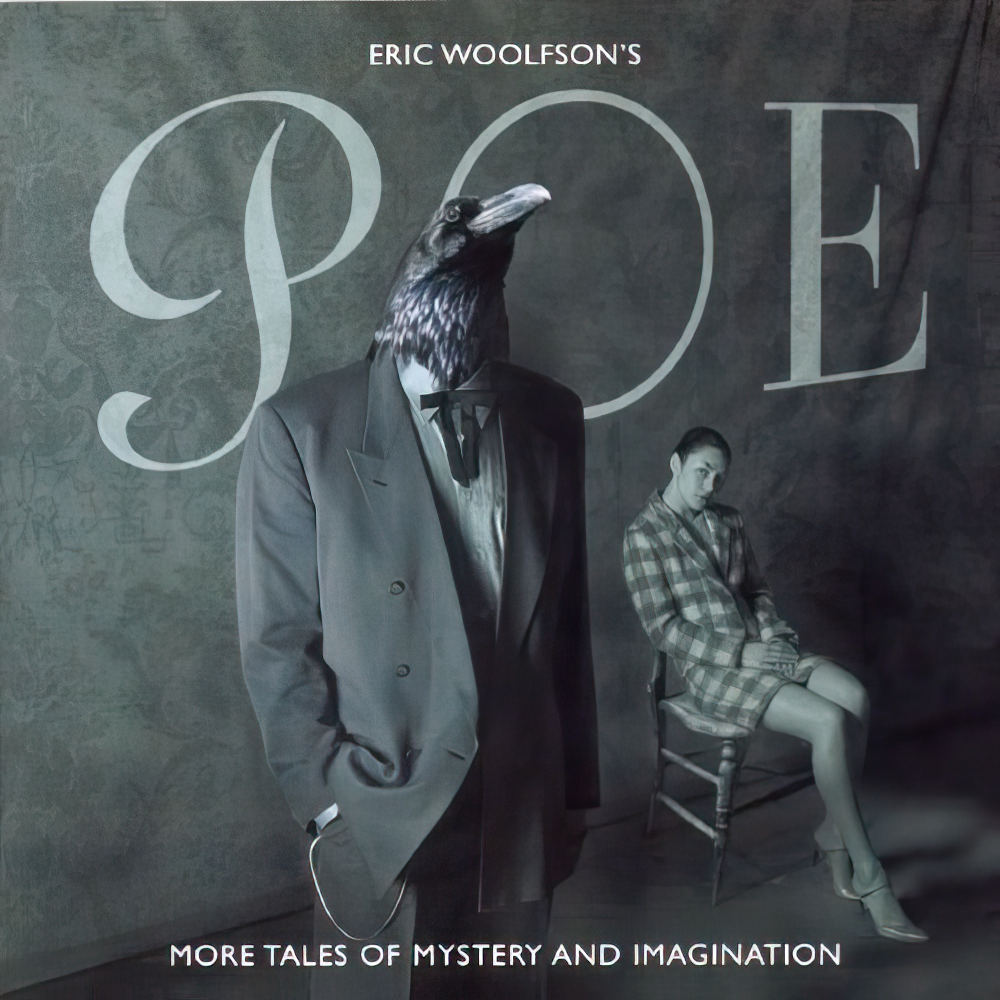
Eric Woolfson’s Poe: More Tales Of Mystery & Imagination
 As most fans of the Alan Parsons Project know, Project co-founder, songwriter and later vocalist Eric Woolfson split from Parsons after the two collaborated one last time on 1990’s Freudiana, an album Parsons produced as a Project concept album but which Woolfson treated as the concept album for a stage musical, the direction he ultimately decided to pursue full-time. Woolfson went on to create several musicals that went down well in Europe, often mining his own Project material for many of the songs. So many fans were surprised to see this 2003 release, boasting an entirely new album of material written by Woolfson which promised to revisit the subject of the very first Project album: Edgar Allan Poe.
As most fans of the Alan Parsons Project know, Project co-founder, songwriter and later vocalist Eric Woolfson split from Parsons after the two collaborated one last time on 1990’s Freudiana, an album Parsons produced as a Project concept album but which Woolfson treated as the concept album for a stage musical, the direction he ultimately decided to pursue full-time. Woolfson went on to create several musicals that went down well in Europe, often mining his own Project material for many of the songs. So many fans were surprised to see this 2003 release, boasting an entirely new album of material written by Woolfson which promised to revisit the subject of the very first Project album: Edgar Allan Poe.
But was Woolfson doing a straight-ahead rock album, or auditioning material for a future musical here? Freudiana proved that one can do both at the same time, but now that we’re about halfway through the Project remaster series, with its early-draft bonus tracks, it’s pretty safe to say that Freudiana – and indeed several Project albums – turned out so well because of the checks and balances that existed in the Woolfson-Parsons partnership, with Parsons reeling in some of Woolfson’s music-hall excesses from time to time. Woolfson on his own, however, doesn’t have that somewhat steadying influence, and the result is this somewhat schizophrenic album.
Parts of Poe are trying hard to be a great rock concept album; in classic Project style, the album starts with an instrumental and then segues into “Wings Of Eagles”, an orchestral rock anthem that thunders along under the sheer power of vocalist Steve Balsamo’s vocals. Balsamo does the vocal duties on much of the album, and his range is mindblowing – he can go from operatic to a throat-thrashing raw rock style that just about reminds me of frequent-flyer Project vocalist Lenny Zakatek. The next song, “Train To Freedom”, is a fantastic piece of music that I’m not sure ever would’ve flown with Parsons in the studio, borrowing from the style of black southern gospel music. Balsamo returns for the ballad “Somewhere In The Audience”.
Next up is a musical rendition of “The Bells”, performed by a mixed choir called the Metro Voices, and it’s really one of the weak points of the album. I will admit to a bias here – I’m quite familiar with Poe’s written works, and “The Bells” simply isn’t among my favorites. Translating it into a stagey musical format doesn’t improve that – it just sounds a bit silly. After “The Bells”, the three-part mini-rock-opera “The Pit And The Pendulum” is a refreshing course correction, with Balsamo back at center stage in what may well be the most Project-esque song on the entire album.
Woolfson then steers things back toward a stage musical direction with “The Murders In The Rue Morgue”, which seems to be trying hard to emulate Freudiana‘s “It’s Funny You Should Say That”, complete with silly character voices; I’ve listened to this album about half a dozen times as of this writing, and I’ll confess to having skipped this track on all but two of those listens. Balsamo returns for another ballad, “Tiny Star”, followed by another choral number, “Goodbye To All That” (which isn’t all that, bogged down again by Woolfson’s stagey sensibilities).
The final song on the album is a bit of a shocker, opening with Orson Welles’ narration recorded for the original 1976 Alan Parsons Project debut album Tales Of Mystery & Imagination (but not used as part of the album until the revised 1987 CD edition), and becoming a rather intense power ballad showcasing Balsamo’s impressive vocal range. The song itself ponders the nature of immortality, and whether or not Poe unwittingly achieved it through his work.
 More Tales would be a fantastic album, except for the 25% of it that succumbs to Woolfson’s stage musical excesses. While he pulls off a couple of things here that I don’t think we would’ve been treated to if Parsons had been involved in this album (namely “Train To Freedom”), More Tales isn’t on a par with, say, Freudiana. Freudiana‘s stagier pieces at least worked within the context of the album, while their counterparts on More Tales completely interrupt any musical flow that the album might have. On the plus side, we get Steve Balsamo’s simply amazing performances and some fairly decent songs out of the deal. It’s no Alan Parsons Project album, sure, and while it’s probably not fair to expect anything even approaching one, it’s also inevitable that the comparison will be made.
More Tales would be a fantastic album, except for the 25% of it that succumbs to Woolfson’s stage musical excesses. While he pulls off a couple of things here that I don’t think we would’ve been treated to if Parsons had been involved in this album (namely “Train To Freedom”), More Tales isn’t on a par with, say, Freudiana. Freudiana‘s stagier pieces at least worked within the context of the album, while their counterparts on More Tales completely interrupt any musical flow that the album might have. On the plus side, we get Steve Balsamo’s simply amazing performances and some fairly decent songs out of the deal. It’s no Alan Parsons Project album, sure, and while it’s probably not fair to expect anything even approaching one, it’s also inevitable that the comparison will be made.
- Angel Of The Odd (2:36)
- Wings Of Eagles (4:45)
- Train To Freedom (4:40)
- Somewhere In The Audience (4:47)
- The Bells (5:32)
- The Pit And The Pendulum – Part I (2:31)
- The Pit And The Pendulum – Part II (2:02)
- The Pit And The Pendulum – Part III (2:02)
- The Murders In The Rue Morgue (4:35)
- Tiny Star (2:44)
- Goodbye To All That (5:15)
- Immortal (5:30)
Released by: Sony
Release date: 2003
Total running time: 46:59
Neutral Milk Hotel – In The Aeroplane Over The Sea
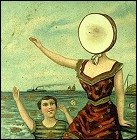 Inspiration is a tricky thing. It can show up in all possible ways and when you very least expect it. Jeff Mangum, the lead singer of Neutral Milk Hotel, wrote and composed most of In The Aeroplane Over The Sea after being inspired by reading The Diary Of Anne Frank, coupled with dreams he had about the girl and a Jewish family. Although the album isn’t explicitly about Frank, her presence lingers, either through the lyrics (“Anna’s ghost all around/hear her voice as it’s rolling and ringing through me”) or song titles (“Holland, 1945”). Like his inspiration, Mangum’s musical world is dreamlike, but also by turns jarring, soft, boisterous and confusing.
Inspiration is a tricky thing. It can show up in all possible ways and when you very least expect it. Jeff Mangum, the lead singer of Neutral Milk Hotel, wrote and composed most of In The Aeroplane Over The Sea after being inspired by reading The Diary Of Anne Frank, coupled with dreams he had about the girl and a Jewish family. Although the album isn’t explicitly about Frank, her presence lingers, either through the lyrics (“Anna’s ghost all around/hear her voice as it’s rolling and ringing through me”) or song titles (“Holland, 1945”). Like his inspiration, Mangum’s musical world is dreamlike, but also by turns jarring, soft, boisterous and confusing.
The album starts off with the song “The King Of Carrot Flowers Pt. One”, in which the narrator describes having an intimate relationship with an unnamed person (“The King Of Carrot Flowers” (?) ) while living under a dysfunctional family (“And your mom would drink until she was no longer speaking/and dad would dream of all the different ways to die/each one a little more than he could dare to try”). By contrast, the next track, “The King Of Carrot Flowers Pt. Two” has Jeff Mangum yelling loudly, “Jesus Christ, I love you!” If you were looking for any clear interpretations, you won’t find them in this album.
In the title track, acoustic guitars are backed by horns and a musical saw, giving it that “barely waking” feel. “Holland, 1945”, arguably the album’s catchiest track and also the album’s “single” (if you can call it that), starts with Mangum counting in the song before fuzzed out guitars explode with a driving drum beat while Mangum’s obscure lyricism continues: “The only girl I’ve ever loved/was born with roses in her eyes…Now she’s a little boy in Spain/playing pianos filled with flames”. “Untitled” has been described by some as “psychedelic bagpipes” and that’s not too far off from the truth.
I’ve heard reports that upon first listening to this album, some people have broken down and cried. Although I  cannot admit to such happenings, it doesn’t surprise me at all. I have never more raw emotion packed into a single album before In The Aeroplane Over The Sea, and I’ll doubt if I’ll hear it again. After the release of In The Aeroplane… Mangum broke up Neutral Milk Hotel and disappeared from the public eye. Released ten years ago, it still sounds as fresh and bold as the day it was written. This album will stay with you.
cannot admit to such happenings, it doesn’t surprise me at all. I have never more raw emotion packed into a single album before In The Aeroplane Over The Sea, and I’ll doubt if I’ll hear it again. After the release of In The Aeroplane… Mangum broke up Neutral Milk Hotel and disappeared from the public eye. Released ten years ago, it still sounds as fresh and bold as the day it was written. This album will stay with you.
- The King Of Carrot Flowers Pt. One (2:00)
- The King Of Carrot Flowers Pts. Two & Three (3:06)
- In The Aeroplane Over The Sea (3:22)
- Two-Headed Boy (4:26)
- The Fool (1:53)
- Holland, 1945 (3:12)
- Communist Daughter (1:57)
- Oh Comely (8:18)
- Ghost (4:08)
- (2:16)
- Two-Headed Boy Pt. Two (5:13)
Released by: Merge
Release date: 1998
Total running time: 39:51
Peter Gabriel – Big Blue Ball
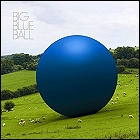 Culled from the open recording days held at Peter Gabriel’s RealWorld Studios in the early to mid 1990s, Big Blue Ball isn’t really necessarily a Peter Gabriel album. Considering how frustrated some of his fans are with the lengthy wait between albums (and I’ll admit that I probably belong in that impatient category), Big Blue Ball may, as such, come off as a disappointment to some listeners. Gabriel doesn’t even perform on every track, even as an instrumentalist – in fact, over 50% of the album is Gabriel-free. So what’s in it for you, the listener? Why bother with Big Blue Ball?
Culled from the open recording days held at Peter Gabriel’s RealWorld Studios in the early to mid 1990s, Big Blue Ball isn’t really necessarily a Peter Gabriel album. Considering how frustrated some of his fans are with the lengthy wait between albums (and I’ll admit that I probably belong in that impatient category), Big Blue Ball may, as such, come off as a disappointment to some listeners. Gabriel doesn’t even perform on every track, even as an instrumentalist – in fact, over 50% of the album is Gabriel-free. So what’s in it for you, the listener? Why bother with Big Blue Ball?
Because even if he doesn’t play on a given track, there’s sort of an unspoken, unwritten stamp of approval that goes with the fact that Gabriel let these folks into the studio, period. Now, I will admit to a certain bias here: the material on which Gabriel does play/sing is the best stuff on Big Blue Ball by a long shot. But this doesn’t make the seven out of eleven songs where he doesn’t appear instant skip material. Gabriel’s penchant for encouraging ethnic fusion artists and trying to break various styles of world music out into wide exposure means that there’s actually more cohesion among the tracks than you might think.
And some of the artists heard here are legends in their own parts of the world. One can hear, in the hypnotically relaxing “Altus Silva”, the genesis of a sound that some of its musicians would later make their own under the name of Afro-Celt Sound System. I was pleasantly surprised to see former World Party one-man-band Karl Wallinger all over this album. Long, long ago, I remember reading in Rolling Stone that Tim Finn – circa his “ALT” collaboration with Liam O’Maonlai and Andy White – had participated in some sessions with Gabriel, and when Tim’s name didn’t surface anywhere on Up, I guessed that whatever he had worked on had been buried. But one of those recordings is the first track on here, and it’s a winner. Other standouts – with out without Gabriel – include, at long last, a definitive (and somewhat tweaked) release of the single “Burn You Up, Burn You Down” (which dates back to Up‘s release and really should have not only been on that album, but should’ve also been its lead single), as well as a song called “Exit Through You” whose percussion toward the end completely fascinates me. “Forest” and “Habibe” are engrossing world music tracks. In fact, the only track I consistently skip is “Jijy” – there’s nothing wrong with the song, but I have to be in a certain mood for rap, let alone rap in another language. But it’s still pretty catchy.
 So while some fans expecting a full-on Gabriel album might be disappointed, there’s plenty of music to enjoy on Big Blue Ball. I get cranky about the huge gaps between albums in Gabriel’s repertoire, but this whole thing – with or without his direct influence – feels authentically Peter Gabriel enough that I’m happy with this until the next one comes along (and if that’s not enough, he also has a couple of songs on the Wall-E soundtrack album that aren’t on Big Blue Ball.) It’s a solid collection that’ll tide fans of Gabriel and world music in general over for a while – if you give it time to grow on you.
So while some fans expecting a full-on Gabriel album might be disappointed, there’s plenty of music to enjoy on Big Blue Ball. I get cranky about the huge gaps between albums in Gabriel’s repertoire, but this whole thing – with or without his direct influence – feels authentically Peter Gabriel enough that I’m happy with this until the next one comes along (and if that’s not enough, he also has a couple of songs on the Wall-E soundtrack album that aren’t on Big Blue Ball.) It’s a solid collection that’ll tide fans of Gabriel and world music in general over for a while – if you give it time to grow on you.
- Whole Thing (5:29)
featuring Francis Bebey, Alex Faku, Tim Finn, Peter Gabriel, Karl Walllinger, Andy White- Habibe (7:14)
featuring Natacha Atlas, Hossam Ramzy, Neil Sparkes- Shadow (4:29)
featuring Juan Cañizares, Papa Wemba- Altus Silva (6:09)
featuring Joseph Arthur, Ronan Browne, Deep Forest, James McNally, Iarla O’Lionáird, Vernon Reid- Exit Through You (5:54)
featuring Joseph Arthur, Peter Gabriel, Karl Wallinger- Everything Comes From You (4:44)
featuring Richard Evans, Joji Hirota, Sevara Nazarkhan, Sinead O’Connor, Guo Yue- Burn You Up, Burn You Down (4:32)
featuring Billy Cobham, Peter Gabriel, The Holmes Brothers, Wendy Melvoin, Arona N’Diaye, Jah Wobble- Forest (6:18)
featuring Levon Minassian, Arona N Diaye, Vernon Reid, Hukwe Zawose- Rivers (5:46)
featuring Vernon Reid, Marta Sebestyen, Karl Wallinger- Jijy (4:01)
Arona N’Diaye, Rossy, Jah Wobble- Big Blue Ball (4:52)
Peter Gabriel, Manu Katché, Karl WallingerReleased by: RealWorld
Release date: 2008
Total running time: 59:28
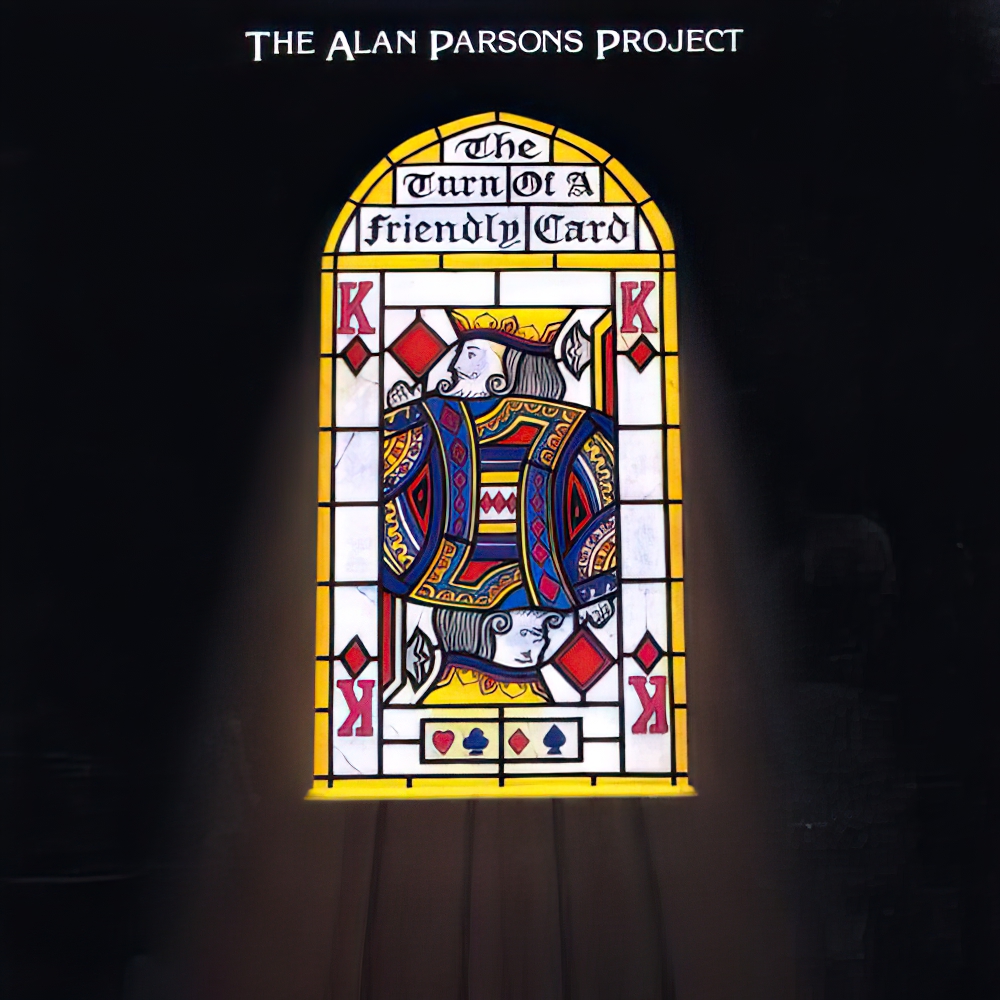
Alan Parsons Project – The Turn Of A Friendly Card (remastered)
 Inspired by the thrills and occasional lose-it-all spills of gambling, The Turn Of A Friendly Card was a turning point for the Alan Parsons Project, turning the band from a strictly underground but well-respected prog rock act known for intricately produced concept albums to a group that actually made a dent on the mainstream charts. For whatever reason, “Time” and “Games People Play” both made an impact far beyond the Project’s usual fan base, creating the anticipation that helped to fuel the meteoric rise of Eye In The Sky (as both album and song).
Inspired by the thrills and occasional lose-it-all spills of gambling, The Turn Of A Friendly Card was a turning point for the Alan Parsons Project, turning the band from a strictly underground but well-respected prog rock act known for intricately produced concept albums to a group that actually made a dent on the mainstream charts. For whatever reason, “Time” and “Games People Play” both made an impact far beyond the Project’s usual fan base, creating the anticipation that helped to fuel the meteoric rise of Eye In The Sky (as both album and song).
As usual, the album we’re all accustomed to is remastered nicely, and Turn also boasts, hands-down, the best bonus tracks of this second wave of Project reissues. A lot of the attention on the bonus tracks is lavished on the song “Nothing Left To Lose”, which was, along with the hit single “Time”, one of the first two Project tunes with a lead vocal by Eric Woolfson. “Nothing” is heard in an early instrumental mix, a demo mix with Woolfson’s vocal and a rough synth attempt at the song’s accordian solo, and – the real treat – the multi-tracked backing vocal magic of Chris Rainbow with everything else mixed down. That selection is particularly impressive because the background vocals were literally all just one guy, and it’s beautiful stuff.
The other gem of the bonus material is an alternate take of “Games People Play”, with a slightly different take on the vocals by Lenny Zakatek and a slightly different approach to the percussion (the liner notes booklet even mentions the infamous Christopher Walken “more cowbell!” sketch from Saturday Night Live here). The song isn’t madly different, but it’s neat to hear a slightly altered version of it. “Time” is included as an instrumental, along with an early demo of “The Gold Bug” instrumental. Also rescued from the demo heap is the first attempt at the intro from “May Be A Price To Pay”, which is actually longer in this form and starts to approach the kind of complexity more listeners would associate to the echoplexed keyboards of “Mammagamma”. The bonus material on this album is great listening in and of itself, and though the entire series of Project remasters has promised to bring us rough mixes, alternate takes and other material to let you  hear the evolution of the songs, Friendly Card may be the remastered album that comes closest to fulfilling that promise.
hear the evolution of the songs, Friendly Card may be the remastered album that comes closest to fulfilling that promise.
Highly recommended for fans of the Alan Parsons Project, though there may even be some interest in the bonus material for more casual listeners as well.
- May Be A Price To Pay (5:01)
- Games People Play (4:23)
- Time (5:09)
- I Don’t Wanna Go Home (4:59)
- The Gold Bug (4:32)
- The Turn Of A Friendly Card (Part I) (2:43)
- Snake Eyes (3:17)
- The Ace Of Swords (2:58)
- Nothing Left To Lose (4:07)
- The Turn Of A Friendly Card (Part II) (3:31)
- May Be A Price To Pay (intro demo) (1:32)
- Nothing Left To Lose (instrumental backing track) (4:37)
- Nothing Left To Lose (Chris Rainbow vocal overdub compilation) (2:01)
- Nothing Left To Lose (early studio version with Eric’s guide vocal) (3:11)
- Time (early studio attempt – instrumental) (4:42)
- Games People Play (rough mix) (4:32)
- The Gold Bug (demo) (2:50)
Released by: Sony / Legacy
Release date: 2008 (original album released in 1980)
Total running time: 64:05
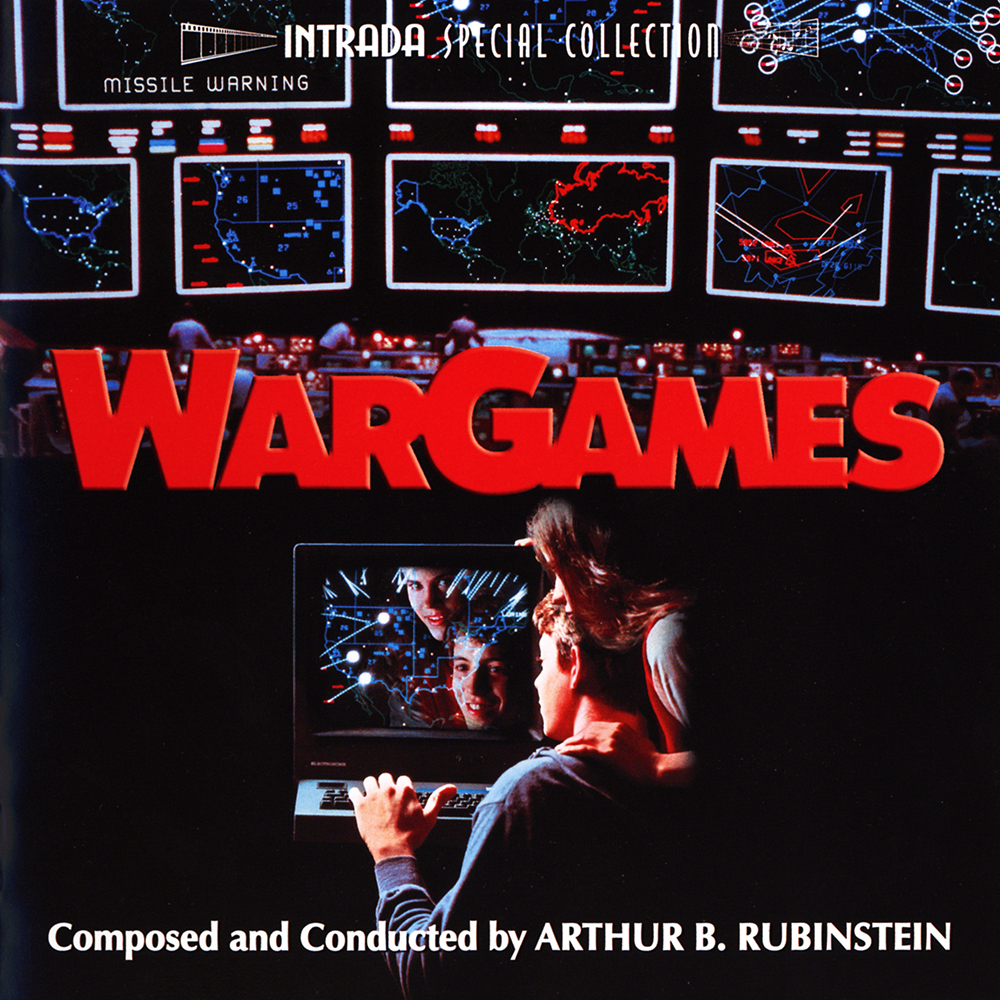
WarGames – music by Arthur B. Rubenstein
I’ve always been a big fan of WarGames, so I was more than happy to hear that the imminent reissue of the original movie – which is resurfacing to help promote a direct-to-video sequel – had lit a fire under someone to release the original soundtrack on CD. Selections from the WarGames score were made available about ten years ago on a composer promo CD, The Film Music Of Arthur B. Rubenstein, but that selection amounted to barely half an hour of music. The fine folks at soundtrack specialty label Intrada have dug up the complete original score, remastered it, and made it available at last.
My first thought upon listening to it, however, was that as fond as I was of the movie, I didn’t remember its music being this good. Rubenstein’s score is just sheer genius in how it establishes and then uses motifs and themes for the movie’s characters and ideas. WarGames truly is one of the best film scores of the 1980s. And it’s definitely a creature of the ’80s too, with a couple of new-wave-esque songs anchoring the early themes in the movie. Done in a style slightly reminiscent of Lene Lovich, “Video Fever” and “History Lesson” roll out themes for Matthew Broderick’s character and his playful attempts to hack into the system. The melodies and other elements from those songs are then picked up by the orchestral score and used to great effect. And for source music pieces that are only ever fleetingly heard in the background, the songs are good listening in their own right.
Early in the score, light-hearted bubbly synths pick up the “Video Fever” theme, but as the story’s dramatic tension is ratcheted up, the synths disappear – until they re-emerge in an extremely sinister theme (actually an ominously minor-key variation on “History Lesson”) for the WOPR computer’s attempts to do some hacking of its own to find a launch code enabling it to launch America’s nuclear arsenal.
Perhaps the best-known piece of the score is one that was only heard at two points in the movie, on of them being the end credits. Rubenstein co-authored a third song, “Edge Of The World”, and tried recording it in a number of different format, including a female soloist and a female choir, before it finally all but vanished from the film, becoming the wistful harmonica-led end credit theme. The various tries at a definitive version of “Edge” with vocals are presented here at the end of the disc, offering an interesting look at music that didn’t make it into the movie. I have to say, though, that the end credit music is still my favorite iteration of “Edge”, and has stuck with me since I originally saw the movie in the theater.
 Quite a few people have fond memories of this movie, but I’m not sure if it’s ever really sunk into the public consciousness how great the music from the movie is. Perhaps this long overdue soundtrack release will help to redress that balance.
Quite a few people have fond memories of this movie, but I’m not sure if it’s ever really sunk into the public consciousness how great the music from the movie is. Perhaps this long overdue soundtrack release will help to redress that balance.
- WarGames (3:41)
- Video Fever (2:23)
- Principal’s Office (1:51)
- A New Grade (2:09)
- The Game Begins (2:44)
- History Lesson (1:46)
- Home Movie (1:28)
- A Game Of Chess? (3:04)
- Nuclear Alert (2:59)
- Walk Thru NORAD (2:18)
- David Captured (3:55)
- David Searches (1:34)
- The Sneak (2:21)
- NORAD (0:58)
- It Could Be War (0:43)
- Confidence Is High (1:11)
- Off To See Faulken (1:09)
- WOPR (2:15)
- Maneuvers (1:38)
- Faulken’s House (1:55)
- Time’s Up (0:19)
- I Can’t Swim (1:31)
- David’s Concern (2:23)
- Helicopter Pursuit / Launch Detected (2:48)
- Closing The Mountain (1:52)
- Who’s First (2:08)
- Joshua! (2:38)
- It Might Be Real (0:59)
- Tic Tac Toe (1:35)
- Winner: None (1:47)
- End Credits (3:22)
- Edge Of The World – choral version (2:08)
- Winner: None – original version (1:47)
- Edge Of The World – vocals by Yvonne Ellman (1:52)
Released by: Intrada
Release date: 2008
Total running time: 69:11
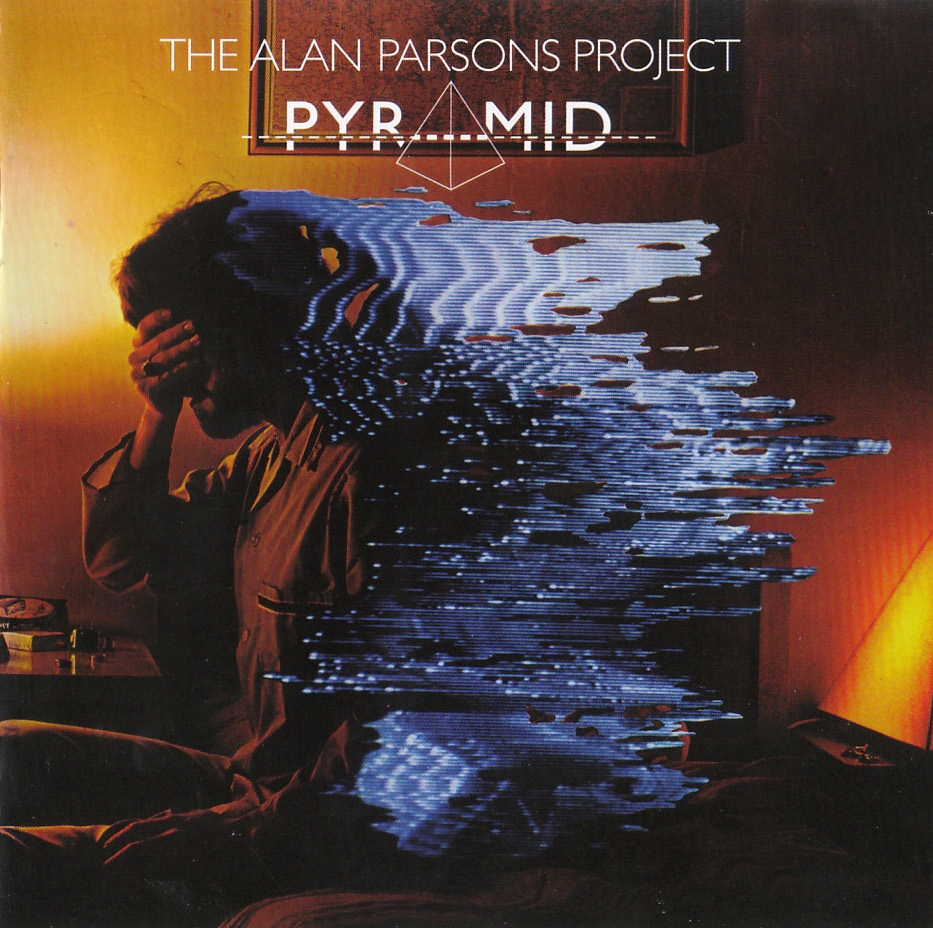
Alan Parsons Project – Pyramid (remastered)
 Though I reviewed the original release of this album quite a while back, this is the remastered and expanded version issued by Sony after its acquisition of the Arista back catalog. Over the years I’ve waffled a bit on what my favorite Alan Parsons Project albums are, but Pyramid and Eve are the two I keep coming back to, because the melding of theme/concept and music are just about perfect. In its remastered form, Pyramid is quite literally loud and clear, though it’s worth noting that I really didn’t have any complaints about the album in its original form. The remaster adds some alternate takes and backing-track-only mixes – essentially, the musical equivalent of DVD deleted scenes – of ther material that’s already available. There aren’t any unreleased tracks from the Pyramid sessions – or at least, not any that anybody wanted to put on this CD.
Though I reviewed the original release of this album quite a while back, this is the remastered and expanded version issued by Sony after its acquisition of the Arista back catalog. Over the years I’ve waffled a bit on what my favorite Alan Parsons Project albums are, but Pyramid and Eve are the two I keep coming back to, because the melding of theme/concept and music are just about perfect. In its remastered form, Pyramid is quite literally loud and clear, though it’s worth noting that I really didn’t have any complaints about the album in its original form. The remaster adds some alternate takes and backing-track-only mixes – essentially, the musical equivalent of DVD deleted scenes – of ther material that’s already available. There aren’t any unreleased tracks from the Pyramid sessions – or at least, not any that anybody wanted to put on this CD.
The original album tracks have aged gracefully, and if anything – at least to my ears – Pyramid has only gained potency with time. The album’s theme, concerning itself with human mortality and the idea of attempting to attain immortality through what one leaves behind, was quite clearly on display when I first heard Pyramid as a teenager, but with the benefit of 20+ years to think on those topics and to revisit the music, it’s more meaningful now. The entirety of Pyramid is one of the most cohesive concept albums I’ve ever had the pleasure of hearing, and even with the grandiose, sprawling cinematic arrangements, not a note is wasted. “What Goes Up…” remains one of the Project’s all-time best tunes, while I’ve grown to appreciate “Can’t Take It With You” and “One More River” more as the years have gone by. This is a Concept Album with a capital C and a capital A, an organic entity that needs to be heard all in one sitting, despite most of its individual songs being strong enough to stand alone.
The bonus tracks kick off with a lengthy instrumental suite spanning much of the first side of the album (for those who are old enough to think in terms of albums having “sides,” that is), giving you a clearer listen at the intricate arrangements of “What Goes Up…” and “The Eagle Will Rise Again”. The latter is gorgeous even in instrumental form, with Chris Rainbow’s overdubbed-and-overdubbed-again background harmonies being especially worthy of praise. A frequent collaborator with the Project, he often built the entire backing vocals himself, though his contributions have remained largely – if you’ll forgive the awful pun – unsung by many fans and music historians.
A very early demo version of “Voyager” is paired with “Little Voices”, a song that underwent a major reworking to become “What Goes Up…”; you can hear Eric Woolfson experimenting with many of the melodic and harmonic twists and turns that would eventually feature in “What Goes Up…”, as well as messing around with still only vaguely formed lyrics that clearly were in their infancy. Another early demo shows the early evolution of the instrumental “Hyper-Gamma-Spaces”, though the churning background synth line that became that song’s trademark is completely absent, this demo concentrating instead on the main synth melody. A demo and an orchestra-free backing track show the evolution of the epic instrumental “In The Lap Of The Gods”, which always seemed like a soundtrack cue sitting around waiting for a movie to happen.
If there’s a jaw-dropping shocker in Pyramid‘s bonus tracks, it’s an early demo of “The Eagle Will Rise Again”, showing that song’s early life as an acoustic rocker that wouldn’t have been out of place on any pre-Monster R.E.M. album. In fact, the thought struck me that this instrumental tryout of “Eagle” would segue beautifully into “Losing My Religion”. I’ll admit that I never once heard the finished song and thought of it as being a candidate for this treatment. I almost wish now that it had been finished out in this form at some point, just as an experiment. It’s the same tune, but radically reformatted.
Those wondering where to find the latest trio of remastered Project albums in North America will have to brace themselves for paying import prices. Apparently the two remasters which saw general release in the States (I Robot, Eye In The Sky) slid under the radar for most music buyers, and apparently the label suspected they would, with the remaster of Vulture Culture hitting shops in the U.K. and Europe only. (Fortunately, you can click our link and get an imported copy at a not-completely-unreasonable  price.)
price.)
Pyramid is still one of my all-time favorite rock albums, and hearing it with these various “deleted scenes” just helps me to appreciate its strengths and quirks all over again. Definitely one of the better Alan Parsons Project remasters.
- Voyager (2:14)
- What Goes Up… (3:40)
- The Eagle Will Rise Again (4:22)
- One More River (4:16)
- Can’t Take It With You (5:06)
- In The Lap Of The Gods (5:30)
- Pyramania (2:43)
- Hyper-Gamma-Spaces (4:20)
- The Shadow Of A Lonely Man (5:44)
- Voyager / What Goes Up / The Eagle Will Rise Again (Instrumental Version) (8:55)
- What Goes Up / Little Voice (Early Version Demo) (4:07)
- Can’t Take It With You (Early Version Demo) (1:45)
- Hyper-Gamma-Spaces (Demo) (2:21)
- The Eagle Will Rise Again (Alternate Version – Backing Track) (3:20)
- In The Lap Of The Gods (Part 1 – Demo) (3:14)
- In The Lap Of The Gods (Part 2 – Backing Track Rough Mix) (1:55)
Released by: Legacy
Release date: 2008
Total running time: 63:33
Roger Joseph Manning Jr. – Catnip Dynamite
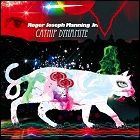 When I listened to former Jellyfish frontman Roger Manning’s debut solo album, Land Of Pure Imagination, a couple of years ago, I was impressed with his amazing studio technique, his harmonies and performances, but not so much with the songs. I’d almost swear the man read my mind, because his new album puts those worries to rest with a solid string of songs that are just freaking fantastic. Fans of melodic, hooky ’70s power pop with great harmony will find this album’s title incredibly appropriate. To narrow it down a bit – if you like Cheap Trick, you’re going to love this.
When I listened to former Jellyfish frontman Roger Manning’s debut solo album, Land Of Pure Imagination, a couple of years ago, I was impressed with his amazing studio technique, his harmonies and performances, but not so much with the songs. I’d almost swear the man read my mind, because his new album puts those worries to rest with a solid string of songs that are just freaking fantastic. Fans of melodic, hooky ’70s power pop with great harmony will find this album’s title incredibly appropriate. To narrow it down a bit – if you like Cheap Trick, you’re going to love this.
The album opens up with “The Quickening”, an anthemic ’70s style rocker with a foot-stomping Gary Glitter-style beat. As cheerful as it is musically, its lyrics bemoan the impatience of youth and the unstoppable, unslowable roller coaster ride of growing older. The vocal harmonies are an awesome wall of sound here, and those who like this song will also get a kick out of “Down In Front” a couple of tracks later. In between is the deceptively cheerful “Love’s Never Half As Good”, a pleasant song that calls to mind a certain breed of well-written, workmanlike ’70s ballad. The description might also apply to “My Girl”, though I find myself liking “Love’s Never Half As Good” much better.
“Imaginary Friend” gets things back onto a rockier course, with a great sonic throwback to the late ’60s/early ’70s rhythm-section-plus-electric-organ sound. “Haunted Henry” is a bit of a ghost of the Jellyfish sound, a catchy story song with a macabre twist – along with Land Of Pure Imagination‘s “Too Late For Us Now”, this is probably the most Jellyfish-esque thing Manning has done since Jellyfish. “Tinseltown” is a nice story song which cautions against seeking fame and fortune at too high a price. As the lyrics chronicle the small-town beginnings of its cast of characters, some very nice pedal steel guitar work starts to creep in, giving the song a vaguely country flavor, though not so much as to completely distract.
“The Turnstile At Heaven’s Gate” features another solid wall of vocal harmony, as well as a brief break for marching band to keep things lively. “Survival Machine” is an epic, nearly eight minutes in length, which is really two songs in one; it’s the kind of anti-war piece that wasn’t at all uncommon in the late 1960s and early ’70s, but seems to be in surprisingly short supply today. The first half of the song is heavy on heavy apocalyptic organ riffs, while the second half gives way to a more bittersweet tone. “Living In End Times” is a sharp-tongued, fast-rocking commentary on folks whose fascination with the Bible seems to begin and end with Revelations. Name-checking everything from “The Late, Great Planet Earth” to “Left Behind”, this is easily the heaviest song – instrumentally speaking – on the whole album, in service of a message that I really wish more people would pick up on.
“Drive Thru Girl” starts out with a mock “live show” intro, and, with tongue planted firmly in cheek, proceeds to turn an amazing number of fast food sales slogans into double entendres set to a cheesy music hall-style accompaniment. This song may not sit well with those who are still waiting for some or all of the former members of Jellyfish to revisit the sound of that group’s glory days, but I found it amusing enough. The album closes with “American Affluenza”, a token anti-consumerist song whose only real disappointment is that the lyrics don’t have much to say. (By contrast, Ben Folds’ “All U Can Eat” is a much more interesting experience lyrically; I also admit to certain built-in skepticism about a song extolling the foibles of American consumer culture when that song has been earmarked as a Japan-exclusive track.)
 Catnip Dynamite is a great bunch of songs, but in places it lets go of enough of its energy that it’s hard to get through in a single sitting. Still, for anyone who, like myself, grew up with the ’70s sound reverberating from their radios (back when it was the ’70s and people actually listened to radio because decent songs could be found there), this album more than lives up to its name.
Catnip Dynamite is a great bunch of songs, but in places it lets go of enough of its energy that it’s hard to get through in a single sitting. Still, for anyone who, like myself, grew up with the ’70s sound reverberating from their radios (back when it was the ’70s and people actually listened to radio because decent songs could be found there), this album more than lives up to its name.
- The Quickening (5:06)
- Love’s Never Half As Good (5:36)
- Down In Front (5:23)
- My Girl (4:09)
- Imaginary Friend (5:07)
- Haunted Henry (4:49)
- Tinsel Town (5:23)
- The Turnstile At Heaven’s Gate (4:40)
- Survival Machine (7:54)
- Living In End Times (5:09)
- Drive Thru Girl (5:15)
- American Affluenza (3:30)
Released by: Phantom
Release date: 2008
Total running time: 62:01
The Peter Br̦tzmann Octet РThe Complete Machine Gun Sessions
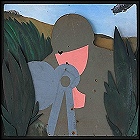 There are three different types of people who will listen to this album. The first person will plug their ears after 10 seconds and turn it off. The second person will continue listening, not out of the respect to the music, but out of morbid curiosity: “Is this a joke? When does the music start?” The third person will listen to the album, listen to it again, and keep on listening. Digging deeper with every nuance of Brötzmann’s music, the listener will find himself faced with the unknown derived from familiarity. It is harsh, brutal and unforgiving — but also captivating and mesmerizing.
There are three different types of people who will listen to this album. The first person will plug their ears after 10 seconds and turn it off. The second person will continue listening, not out of the respect to the music, but out of morbid curiosity: “Is this a joke? When does the music start?” The third person will listen to the album, listen to it again, and keep on listening. Digging deeper with every nuance of Brötzmann’s music, the listener will find himself faced with the unknown derived from familiarity. It is harsh, brutal and unforgiving — but also captivating and mesmerizing.
As the story goes, three things in particular make this album unique. First, Brötzmann employs an octet for the recording of this album. While octets in jazz are not new, they are uncommon (7 years later, Ornette Coleman used an octet for the recording of his album Free Jazz, but he split it up into two quartets who played simultaneously rather than eight musicians playing all at once). The second thing is that they recorded the album not in a studio but rather at a nightclub in Germany, which provided poor acoustics. This worked in Brötzmann’s favor, however, as it added to the “dense”-ness of the album. The third thing that is unique about the record is the music itself.
Yes, it is chaoctic. Brötzmann and Co. play their instruments to the breaking point, with blasts of drums piercing the wails of saxophones and basses. Yes, it is dissonant. There seems to be no trace of melody. In fact, the only time a semblance of song structure creeps in is about 15 minutes into the title track, but the walls of noise soon overtake it. Nevertheless, this is not music that is made simply to be listened to a couple times. It’s something to reflect; examine. It is music that has to be felt.
This new 2007 remaster by Atavistic includes the original LP, and adds two more alternate takes from the same session. There is also a live version of the title track performed two months prior to the studio sessions at the Frankfurt Jazz Festival in 1968. The original LP tracks are great by themselves, but the added material really adds more to the album. The live version in particular is sensational.
Overall, it is a simply astounding piece of work, and one that has few peers in the music archives.

- Machine Gun (17:19)
- Responsible/For Jan Van De Ven (8:20)
- Music for Han Bennink (11:29)
- Machine Gun (Second Take) (15:01)
- Responsible/For Jan Van De Ven (First Take) (10:08)
- Machine Gun (Live) (17:40)
Released by: Atavistic
Release date: 1968 (re-released 2007)
Total running time: 79:53
Stargate: Ark Of Truth – music by Joel Goldsmith
 The Stargate television franchise has used a full orchestra on precisely two occasion: the 1997 pilot episode of SG-1. and the 2004 pilot movie of Stargate Atlantis. Everything that has come since has been the product of synthesizers, and in the early years of Stargate SG-1 there was even quite a diverse mix of composers whose work – dating back to the first season – was mixed-and-matched as needed, like the original Star Trek’s library approach to its music. So it’s quite a shock to the system to suddenly return to a real orchestra and a real choir with Ark Of Truth, the first of two post-cancellation direct-to-DVD movie projects for the cast and crew of SG-1.
The Stargate television franchise has used a full orchestra on precisely two occasion: the 1997 pilot episode of SG-1. and the 2004 pilot movie of Stargate Atlantis. Everything that has come since has been the product of synthesizers, and in the early years of Stargate SG-1 there was even quite a diverse mix of composers whose work – dating back to the first season – was mixed-and-matched as needed, like the original Star Trek’s library approach to its music. So it’s quite a shock to the system to suddenly return to a real orchestra and a real choir with Ark Of Truth, the first of two post-cancellation direct-to-DVD movie projects for the cast and crew of SG-1.
Resident Stargate maestro Joel Goldsmith is naturally at the helm here, and as usual, he has no trouble switching from synthesized/sampled orchestral music to the real deal. The soundtrack opens with a restatement of the Stargate theme we’ve heard for years – itself adapted from David Arnold’s music from the 1994 movie – but with a different emphasis and tempo than the SG-1 main titles, letting us know immediately that things are a little bit different. (I could stop here and point out that, despite the grandiosity of the music, things aren’t that different and Ark feel like two episodes jammed together that, give or take the large scale of a couple of its setpieces, could’ve easily been done on TV, but maybe I’d better just stick to the music.)
Themes are quickly established for the multiple angles of attack of the story: the Tomin/Vala angle gets its own motif, the SG-1 team gets its own noble sound, and the Ori get to sound like big, dark trouble, which is somehow appropriate. Later in the proceedings some ominous rumbling kicks in, which then turns into something more percussive for the somewhat surprising return of the Replicators. There are also themes for the Ancients and – to a certain extent – the Ark itself . However conceptually modest Ark‘s story may have been, the music is Widescreen with a capital W. It’s the same guy writing and arranging the music, but it probably doesn’t need to be said that Goldsmith goes to town with the opportunity to have real players, real instruments and real voices playing his material. To say that there’s a generous quantity of music here is an understatement – you get pretty much the entire score here, an hour of big orchestral/choral music for a direct-to-DVD movie with a running time of under two hours.
For a tiny label release, Ark Of Truth gets relatively lavish packaging too, with a booklet that extensively discusses the movie’s genesis, the team who produced it, and the long-standing relationship between the producers and Goldsmith, all lavishly illustrated. This material might not be here making for such a thick booklet, except that this was obviously a release catered to the fanbase of the show. 100 copies were autographed for those who ordered early from Goldsmith’s website, a window of opportunity which seemed to vanish like a closing wormhole, but faster.
Ark Of Truth has some great music, with something interesting always afoot even if it’s not thundering along on the musical equivalent of a war footing. One has to appreciate Joel Goldsmith taking the chance to not do this as a “composer promo,” which usually sees the studio quietly grumbling and looking the other way as a composer quietly releases a CD which serves as a resume piece (and, in more recent years, usually earns back its own production costs as it slips out into the hands of diehard fans). Instead, Goldsmith went to MGM and licensed it for a full release through his own label, with studio- sanctioned artwork and all – basically, putting whatever money he’d made from doing the music back into the studio’s coffers and taking a gamble that he’d make it back by putting the CD on the market. Hopefully – despite this being the age of Downloading Absolutely Everything Whether You’re Supposed To Or Not – the loyal fans make sure that gamble pays off, because I’m much more interested in the second SG-1 DVD movie, Continuum, and I’m eager to hear its soundtrack as well.
sanctioned artwork and all – basically, putting whatever money he’d made from doing the music back into the studio’s coffers and taking a gamble that he’d make it back by putting the CD on the market. Hopefully – despite this being the age of Downloading Absolutely Everything Whether You’re Supposed To Or Not – the loyal fans make sure that gamble pays off, because I’m much more interested in the second SG-1 DVD movie, Continuum, and I’m eager to hear its soundtrack as well.
- The Decision (Main Title) (3:53)
- Dakara Discovery (2:06)
- Tomin (3:06)
- The Wrong Ark (3:36)
- My Notebook (1:55)
- Our Mission Begins (1:25)
- The Supergate (2:19)
- Meeting The Resistance (2:25)
- Sabotage (2:19)
- Replicator! (2:05)
- Merlin (2:07)
- Ori Fleet (3:39)
- The Doci (1:57)
- Journey To Celestis (2:09)
- The Battle Begins (2:34)
- Maternal Moment (2:20)
- The Healing (1:24)
- Morgan Le Fay (3:45)
- Marrick’s Demise (3:05)
- The Ark Of Truth (6:04)
- See The Light (0:54)
- Carter’s Cookies (2:19)
- A New Adventure (0:47)
Released by: Free Clyde Music
Release date: 2008
Total running time: 58:13
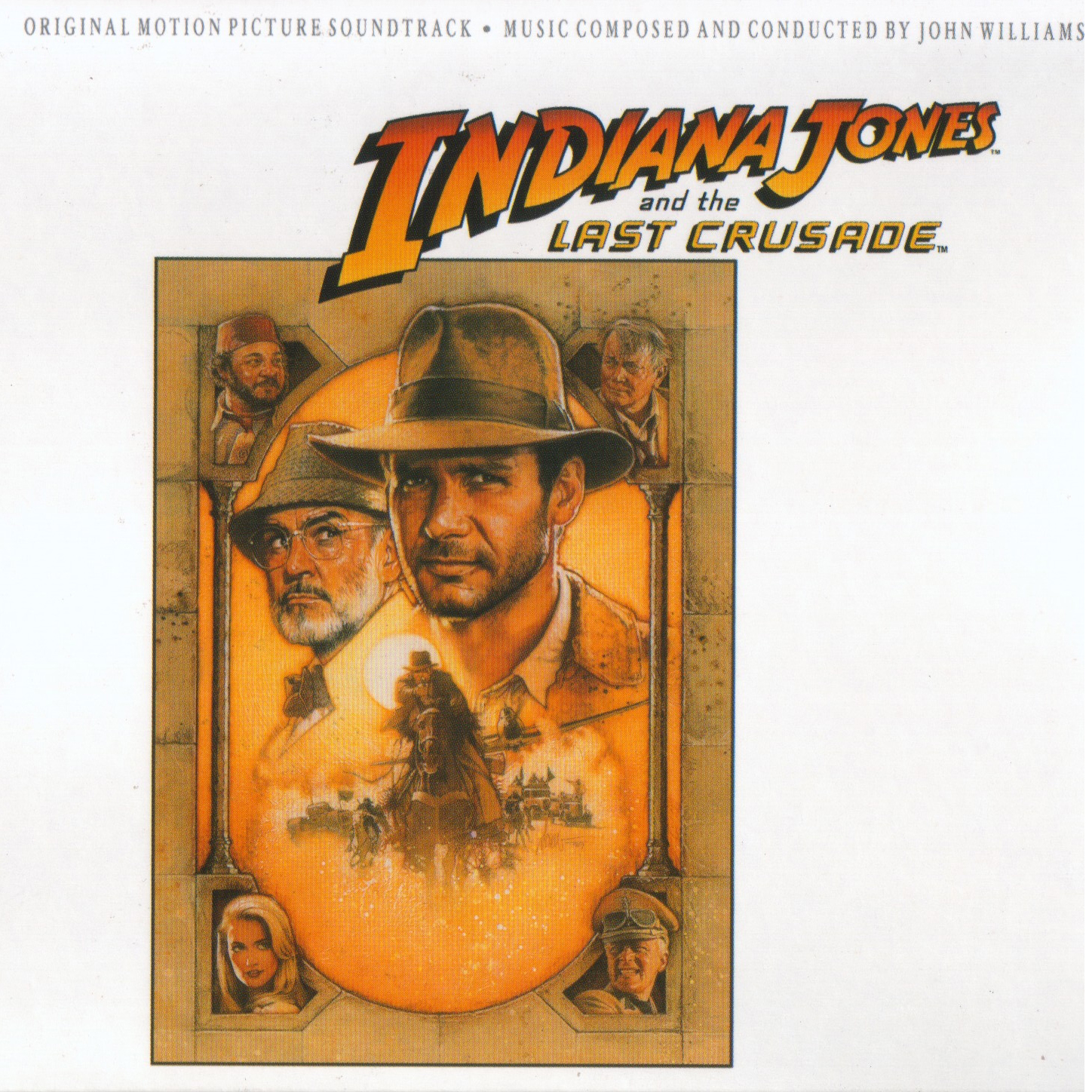
Indiana Jones And The Last Crusade – music by John Williams
 In Indiana Jones And The Last Crusade, John Williams composes the music for the last film in this famous series (or at least, we thought back then). In my review of Indiana Jones And The Temple Of Doom, I said that the album had an overall majestic feel. In this album, Williams decides to go for a more orchestral feel, with heavy usage of stringed instruments. It almost feels ambient in certain places, with very quiet sustained notes and light dynamics in the piece, like in “The Penitent Man Will Pass”.
In Indiana Jones And The Last Crusade, John Williams composes the music for the last film in this famous series (or at least, we thought back then). In my review of Indiana Jones And The Temple Of Doom, I said that the album had an overall majestic feel. In this album, Williams decides to go for a more orchestral feel, with heavy usage of stringed instruments. It almost feels ambient in certain places, with very quiet sustained notes and light dynamics in the piece, like in “The Penitent Man Will Pass”.
The album starts with “Indy’s Very First Adventureâ€, a calm track that soon breaks into strings and flutes and then later on picks up in excitement and dynamics. “X Marks The Spot” builds up the usage of horns, but soon falls into the aforementioned ambience.
In “Scherzo For Motorcycle And Orchestra”, John Williams shows off his classical chops. “Scherzo” is an Italian word for “joke”, and usually used as a term for a single movement in a larger symphony. Williams lives up to the title by giving the song a playful feel, with a return of the Indiana Jones theme throughout the song. Unfortunately, there seems to be no motorcycle included in the piece.
“Ah, Rats!!!” returns to Williams’ use of dissonance, using it to punctuate deep dark tones and create a sense of anxiety (most likely to Indiana Jones’ loathing of the aforementioned rodents). “The Keeper Of The Grail” starts with sustained notes and again, a sense of ambience, but soon breaks into a slow emotional piece. On the other hand, “Keeping Up With The Joneses” is an up-tempo track, brassy and dramatic.
 Williams again upholds a fine standard for film music, and give The Last Crusade a worthy send-off. It will be interesting to hear what he has up his sleeve for Kingdom Of The Crystal Skull, but one can almost be assured that it will fall neatly with the rest of the music from this series.
Williams again upholds a fine standard for film music, and give The Last Crusade a worthy send-off. It will be interesting to hear what he has up his sleeve for Kingdom Of The Crystal Skull, but one can almost be assured that it will fall neatly with the rest of the music from this series.
- Indy’s Very First Adventure (8:13)
- X Marks The Spot (3:11)
- Scherzo For Motorcycle And Orchestra (3:52)
- Ah, Rats!!! (3:40)
- Escape From Venice (4:23)
- No Ticket (2:44)
- The Keeper Of The Grail (3:23)
- Keeping Up With The Joneses (3:36)
- Brother Of The Cruciform Sword (1:55)
- Belly Of The Steel Beast (5:28)
- The Canyon Of The Crescent Moon (4:16)
- The Penitent Man Will Pass (3:22)
- End Credits (Raiders March) (10:37)
Released by: Warner Bros.
Release date: 1989
Total running time: 58:40
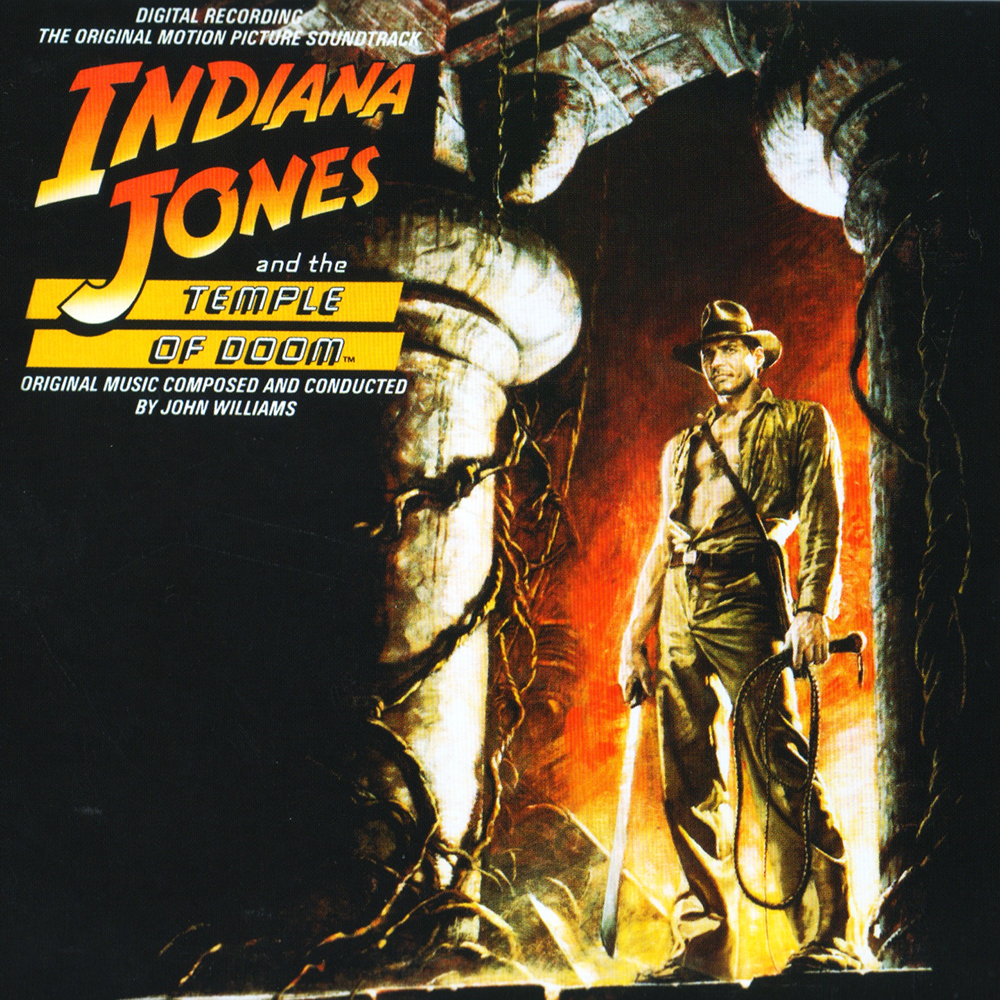
Indiana Jones And The Temple Of Doom – music by John Williams
 John Williams. Steven Spielberg. Two great tastes that taste great together. Ever since Williams worked on Spielberg’s first theatrical film, The Sugarland Express, the two have been nearly inseparable. So, again they pair up for Indiana Jones And The Temple Of Doom, Spielberg’s 8th film (and Williams’ 47th).
John Williams. Steven Spielberg. Two great tastes that taste great together. Ever since Williams worked on Spielberg’s first theatrical film, The Sugarland Express, the two have been nearly inseparable. So, again they pair up for Indiana Jones And The Temple Of Doom, Spielberg’s 8th film (and Williams’ 47th).
This soundtrack album starts off, interestingly enough, with a Mandarin rendition of the famous Cole Porter song, “Anything Goes” sung by the Kate Capshaw, the female lead of the film. This is from an early part of the film where our hero sees her for the first time. Later on, in “Fast Streets Of Shanghai”, Williams employs Oriental influences (as the name suggests) and a dramatic flair that Williams is well known of. Bits of the Indiana Jones theme carry throughout the piece.
On the track “The Temple Of Doom”, chanting is used to give the song a dark, ominous feel as we come across the temple for the first time. “Bug Tunnel And Death Trap” has brief moments of dissonance, underlining the horror of the place. Melodies reach higher and higher, creating a sense of anxiety and confusion. On the other hand, the track “Slave Children’s Crusade” is loud and majestic, with booming cymbals and a strong string section serving as the anchor of the piece.
An interesting thing to note is that John Williams often employs leitmotif in his scores. That is to say, he composes and assigns themes to certain characters or ideas in the films. For example, in the Star Wars series, he composed separate themes for the characters Princess Leia, Yoda and Darth Vader as well as others (although it is Darth Vader’s theme that everyone usually thinks of). On this album, Williams downplays that aspect a bit. Even though the character Short Round has a theme, most of the music is incidental music and not specifically tied to a character. Even Indiana Jones’ own recognizable theme doesn’t make a full appearance until the finale. In my opinion, not having a “stand-out” piece detracts from the work as a whole.
 The soundtrack carries a dramatic feel. One of the recognizable strengths of John Williams is that he very much as a unique styling in his music. You can listen to a piece by Williams and immediately sense that, even if you don’t know explicitly that it is Williams’ work, you know at least it’s meant for a film or a similar endeavor. Overall, a fine score that stands up well on its own apart from the movie.
The soundtrack carries a dramatic feel. One of the recognizable strengths of John Williams is that he very much as a unique styling in his music. You can listen to a piece by Williams and immediately sense that, even if you don’t know explicitly that it is Williams’ work, you know at least it’s meant for a film or a similar endeavor. Overall, a fine score that stands up well on its own apart from the movie.
- Anything Goes (2:51)
- Fast Streets Of Shanghai (3:44)
- Nocturnal Activities (6:01)
- Short Round’s Theme (2:32)
- Children In Chains (2:44)
- Slalom On Mt. Humol (2:26)
- The Temple Of Doom (3:00)
- Bug Tunnel And Death Trap (3:33)
- Slave Children’s Crusade (3:29)
- The Mine Car Chase (3:42)
- Finale And End Credits (6:27)
Released by: Polydor
Release date: 1984
Total running time: 40:29

